Oldest woolshed begins repair project
WORDS: Rosemary Baird IMAGES: Heritage New Zealand Pouhere Taonga
Te Waimate Woolshed, over 160 years old, is undergoing repairs with the help of the Heritage New Zealand Pouhere Taonga National Heritage Preservation Incentive Fund.
Back in the days of the massive South Island sheep stations, the Studholme brothers, original holders of Te Waimate Station, built the woolshed in 1855 to cater to the sheep on their 98,000 acre property. At its peak there were 22 shearing stands and around 100,000 sheep were shorn annually.
The woolshed, with its distinctive doublegabled profile, is an excellent example of early colonial construction techniques. The roof was originally tōtara shingles laid over sarking but is now covered in roofing iron. Much of the woolshed’s
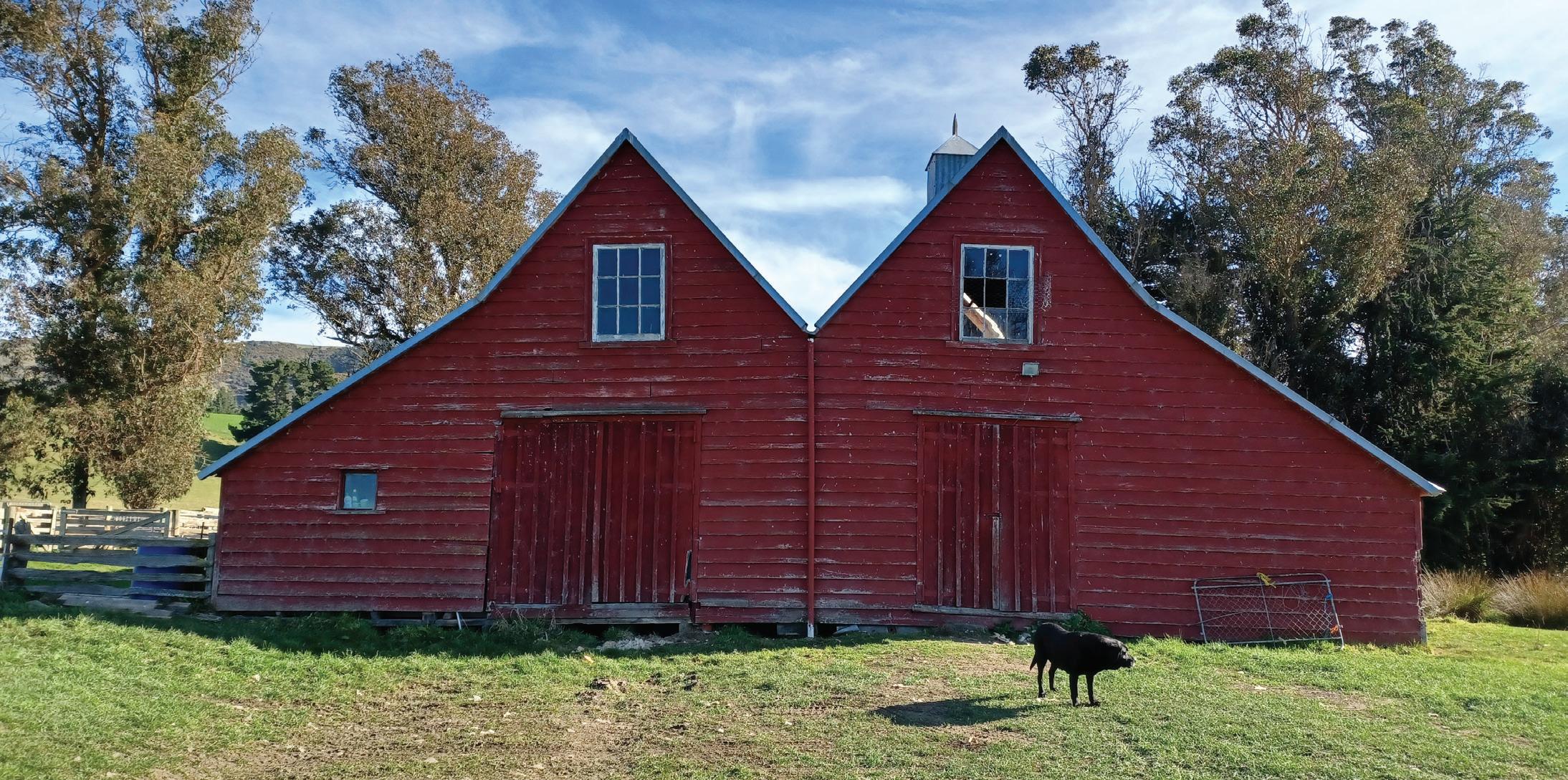
timber is hand-adzed. All the exterior timber is pit-sawn tōtara and the original mānuka railings are preserved by the lanolin from sheep wool. The huge historic Ferrier’s screw wool press still sits inside the woolshed.
Over the years, the building has been added to and repaired. It is now the oldest functioning colonial woolshed in Aotearoa New Zealand and a Category 1 listing on the New Zealand Heritage List/ Rārangi Kōrero. Still owned and run by the Studholme family, parents Michael and Jan Studholme still live onsite but
have passed on the running of the farm to their son Henry and his wife Katie.
The woolshed’s long history of use has come at a cost. The ground levels under the north and south sides of the woolshed have built up from many years of sheep debris. As the ground levels have risen, the piles have begun to rot. The bearers (timber beams) that sit atop the piles now rest on the ground. Damp is the enemy of wood; the old native timbers in the bearers and floor joists are in danger of rotting away. On the south side, poor drainage and rotten weatherboards have
1 Heritage Quarterly NGAHURU • AUTUMN 2023 NGAHURU • AUTUMN 2023 CANTERBURY
Te Waimate Woolshed.
Several years ago, the Studholmes heard about the Heritage New Zealand Pouhere Taonga National Preservation Incentive Fund and decided to apply. Rather than chip away with repairs gradually, they made a successful application to the fund in 2022 for a more comprehensive repair programme. Having started in January 2023, the project plans to initially focus on repairing or replacing rotten timber: the affected piles, joists, bearers, stud ends, windowsills and weatherboards, followed by a new drainage system, and repainting of the exterior.
“We’re lucky to have our builder Mike Simpson involved,” says Henry Studholme. “He has 25 years’ experience and has done lots of work on other heritage buildings. It’s not a normal building job, but Mike is genuinely interested in the project.”
Heritage New Zealand Pouhere Taonga Canterbury/West Coast Conservation Advisor, Mike Gillies, has also been out onsite to support the restoration
This issue
project. “The woolshed has some amazing carpentry work up in the rafters,” he says. “It’s a magnificent building and in good condition considering its age and heavy use.”
The Studholmes found Mike Gillies’ enthusiasm encouraging. “We would have never noticed some of the details that Mike’s keen eyes spotted,” says Henry. “It was great to have him give some practical advice on heritage carpentry techniques and tell us that the project is very doable.”
Michael Studholme hopes that the repair project will give the woolshed a new lease of life. “The wood is beautiful native timber, and most of it doesn’t show any sign of rot. If we can keep the moisture out, we hope to get another century from the woolshed.”
For the Studholmes, being owners of such a significant collection of heritage farming buildings is a responsibility they take seriously. “We’re custodians of the place I suppose,” says Henry Studholme. “You don’t feel like you’re doing it for yourselves; you’re doing it for the next
generation.” The family often welcome interested visitors and schools to learn about the region’s agricultural history. And once the woolshed is repaired, “we have a wee list,” says Henry. “The stables, grain store, stockman’s cottage and outbuildings are all on our radar for conservation and repair.” n
Mike Gillies inspects the original tōtara roofing shingles, intact under corrugated roofing iron.
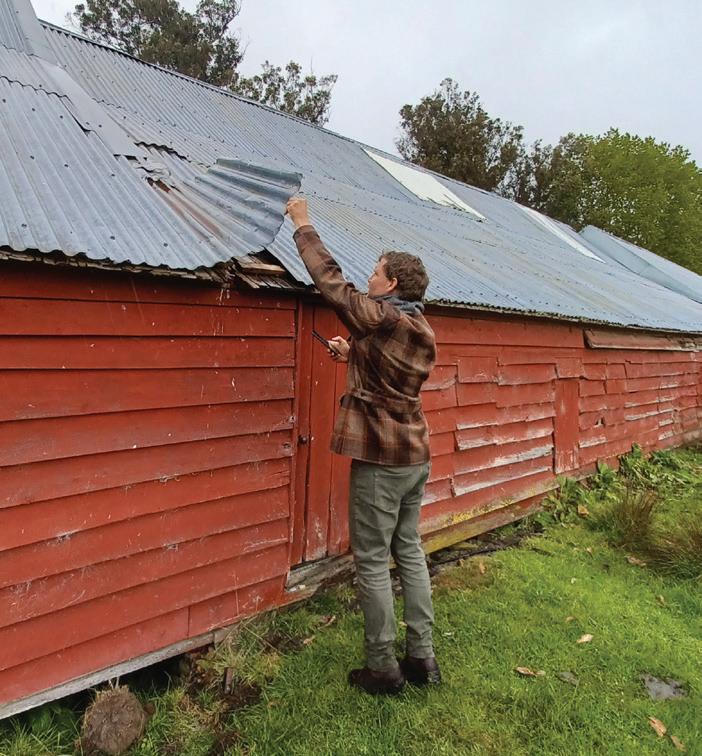
16
heritagenewzealand heritage_nz
@heritagenz
Editor: Adrienne Hannan
Designer: Michael Steele
Published by Heritage New Zealand Pouhere Taonga, Heritage Quarterly keeps you up-to-date with heritage news from around New Zealand.
Copyright © Heritage New Zealand Pouhere Taonga.
All images credit Heritage New Zealand Pouhere Taonga unless otherwise stated.
For more information or to subscribe, write to PO Box 2629, Wellington 6140 or contact the editor, phone: 04 470 8066 or email: ahannan@heritage.org.nz
ISSN 2324-4267 (Print) ISSN 2324-4275 (Online).
oldest
Heritage Quarterly is printed with mineral oil-free, soy-based vegetable inks on Sumo paper. This paper is Forestry Stewardship Council® (FSC®) certified, manufactured from pulp from responsible sources under the ISO 14001 Environmental Management System. Please recycle.
1 CANTERBURY New Zealand's oldest functioning woolshed begins repair project 3 EDITORIAL New futures through restoration and adaptive re-use 4 RAWENE Clendon Collection added to the UNESCO Register 6 ARCHAEOLOGY WEEK Unearthing Aotearoa during Archaeology Week 7 ARCHAEOLOGY PODCAST Maritime archaeology making a splash 8 AUCKLAND Suffrage Memorial recognised with listing 10 TAIHAPE Grandstanding in Taihape 12 AORAKI Important story told at new Tohu Whenua site 14 ANZAC DAY Many ways to remember this Anzac Day
WAIMĀRAMA Fired up on mahi kōhatu
AUCKLAND
Welsford: The evolving heritage of small boat design
Members of Heritage New Zealand can visit its properties for free, visit visitheritage.co.nz. KERIKERI
18
John
20
properties
First fruits – propagating a living link to our
led to cladding breakdown and moisture build-up.
New futures through restoration and adaptive re-use
WORDS: Andrew Coleman IMAGES: Norbert Koptisch
It is a pleasing day when we read about a heritage property that is lifted from a doomed recent past and elevated into a positive future.
Develop a concept – this is the sum of early thinking and planning. What would it take to restore, conserve and protect a heritage property? Seeking advice from experts is something that we would encourage early. Our own in-house specialists have significant experience and welcome discussions, especially in the initial concept and planning phases. Plan, plan and plan some more – create a strong position by engaging contractors early and establishing your finances and contingencies. Consider associated legal and planning requirements, including archaeology. You will see in this Heritage Quarterly edition the wealth of knowledge archaeology can reveal.
Recently there was a published article on the 12 years of work that Lyndia Wood had undertaken transforming the derelict Category 2 heritage listed Rahui Milk Treatment Station into a grand and versatile function centre, one that now has a very viable future.
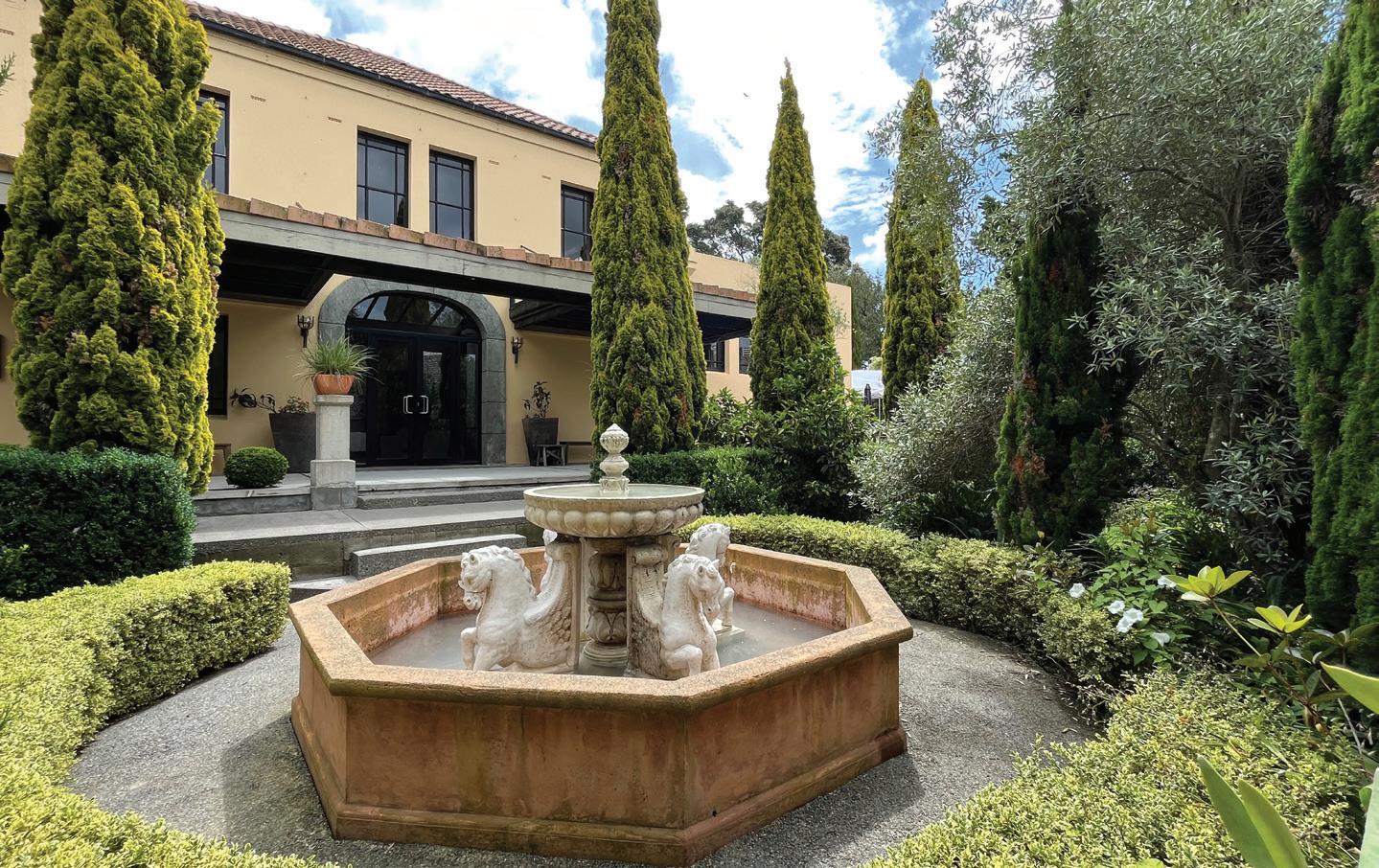
Lyndia was inspired by a vision of the Paris Railway Station and her love of Italianate style design and architecture. Through her courage, dedication and commitment she turned heritage into a modern business, and she was warmly congratulated by us for her efforts.
There are many other inspiring heritage conservation and adaptive re-use examples, with the award-winning Hastings Municipal Building, Invercargill Central Business District, Auckland’s Britomart and our own Melanesian Mission recent standouts.
With our current work on the Hokitika Government Building, Turnbull House and Antrim House, we at Heritage New
Zealand Pouhere Taonga have three very large strengthening, restoration and adaptive re-use projects underway. While each project is unique, together they are inspired and informed by the following things that other heritage projects have taught us.
See past the dereliction – if repairs and maintenance have waned then all properties, not just heritage properties, will look deteriorated, and it’s important to see past this to the potential underneath. Regular upkeep, planned maintenance and condition reports are something that we undertake regularly on the places we care for. It takes inspiration and commitment to see a future and to develop a vision.
See a future use – it is not common to have a heritage building simply repaired and strengthened. Most are adapted for a complete change in use and identifying this is a great motivator. All the examples referenced in this editorial have had a future vision and practical end-purpose as a critical part of their project.
Stay the path – dilemmas and unknowns are almost certain in heritage restoration but keeping your focus on the end prize will help. We have found that having a single certainty, such as the future use, assists thinking on options as we work through unexpected matters. Remember – good things take time, so ensure your plans reflect this.
If you, like us, are taking on a heritage restoration project (or three!), allow yourself to feel a sense of pride that you are continuing and contributing to the story of Aotearoa New Zealand. n
Andrew Coleman Chief Executive

NGAHURU • AUTUMN 2023 3 Heritage Quarterly
EDITORIAL
The Milk Station following extensive restoration work.
Clendon Collection added to the UNESCO Register
WORDS: John O'Hare
A unique collection of family papers spanning almost 150 years, and covering watershed moments in the formation of modern New Zealand, has been added to the UNESCO Aotearoa New Zealand Register of the Memory of the World.
UNESCO recently officially recognised the Clendon Collection, papers associated with James Reddy Clendon and his descendants –including Clendon’s second wife Jane Takotowi Cochrane – as an assemblage of recorded heritage that has national significance.
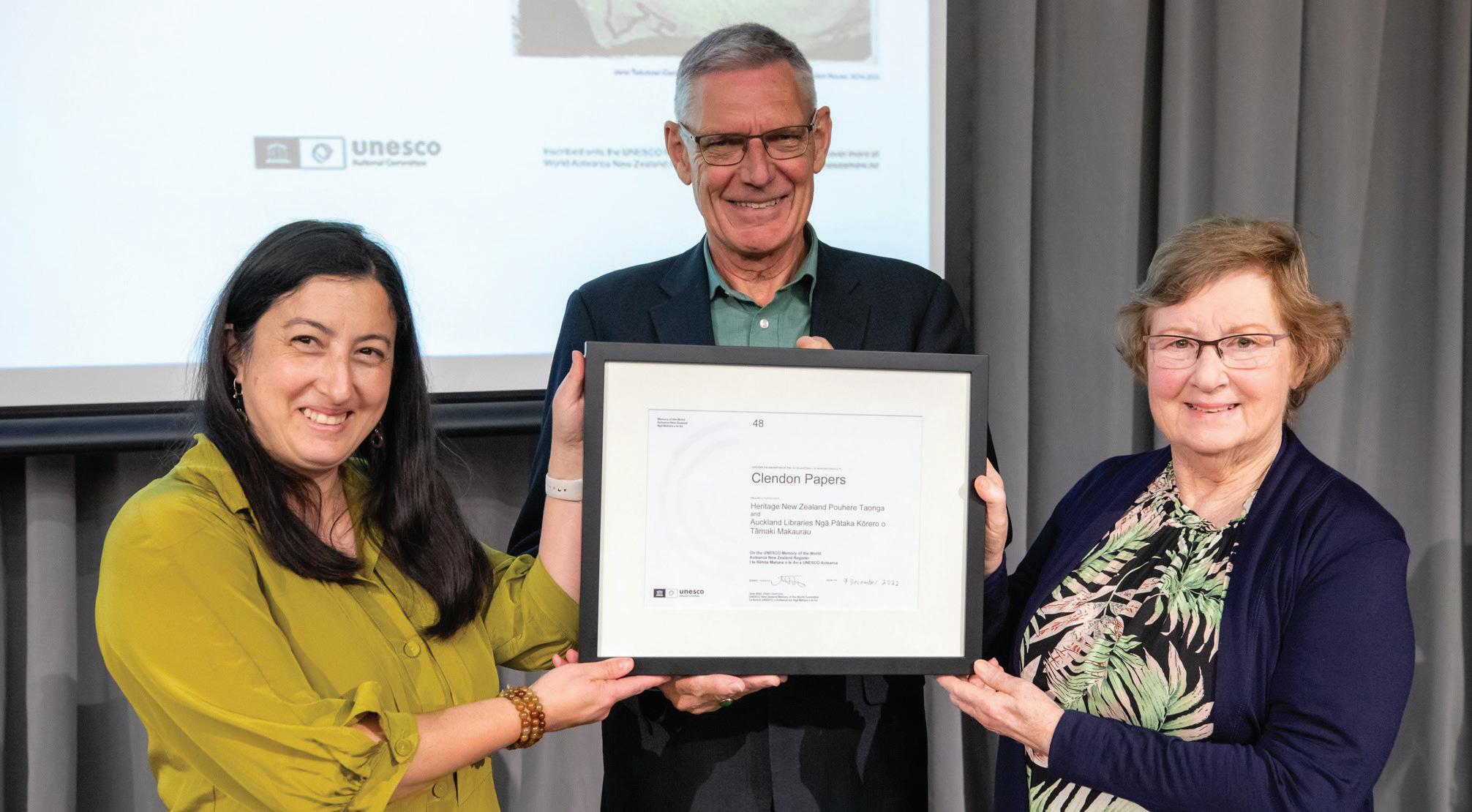
The proposal to add the collection to the Memory of the World was supported by Clendon’s descendants of both his first wife Sarah, and Jane.
The papers are jointly held at Auckland Libraries Ngā Pātaka Kōrero o Tāmaki Makaurau and Clendon House in Rawene, a historic property and Tohu Whenua cared for by Heritage New Zealand Pouhere Taonga. In his latter years the house was the home of James Clendon, Jane, and their descendants for over a century.
Clendon was an early Northland trader, merchant, settler, farmer, government official and the first US Consul in New Zealand. He was also a signatory to He Whakaputanga (the Declaration of Independence) in 1835 and Te Tiriti o Waitangi on 6 February 1840 – literally making history as one of the few Europeans to have his signature on both documents.
“The lives of missionaries in early New Zealand are well documented but the lives of early traders and merchants less so,” says Heritage New Zealand Pouhere Taonga Chief Executive Andrew Coleman. “Although documentation relating to traders like Maning, Webster and Mair exist for the early period of New Zealand history it often doesn’t exist after this. By contrast, the wide range of material in the Clendon Collection, and the fact that the items relate to the life of an early trading
family prominent in the Bay of Islands and the Hokianga for over 140 years, makes this collection unique.”
As well as the importance of family, financial and trading links with England, Australia and the United States from the 1830s to the 1850s, the papers reflect James Clendon’s lifelong involvement with developing government in New Zealand.
“Following British annexation after the signing of Te Tiriti, Clendon resigned his commission as US Consul in 1841 and was appointed to the New Zealand Legislative Council in Auckland. This was later followed by appointments as Land Commissioner, Resident Magistrate, Police Magistrate and as an ‘intelligence gatherer’ during the first Northern War,” says Mr Coleman.
“He held a number of official positions from the 1830s to his retirement in 1867 including Bay of Islands Police Magistrate and resident Magistrate in Russell and then Rawene.”
Following Clendon’s death in 1872, the papers go on to reflect the family’s life in the developing bilingual, biracial society
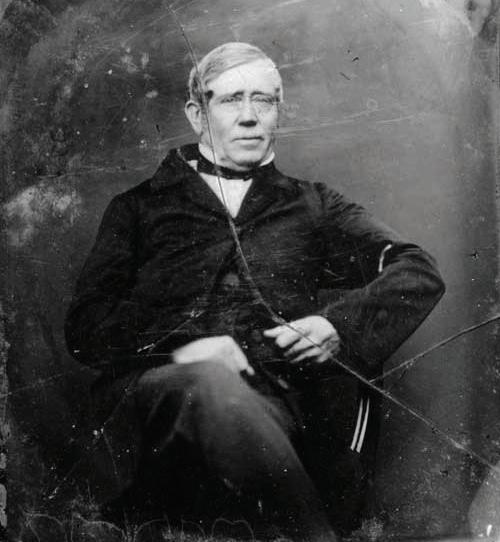
NGAHURU • AUTUMN 2023 4 Heritage Quarterly
UNESCO NZ Secretary General Zuleika Chang (left) with David Clendon and Barbara Gawath, both descendants of James Reddy Clendon. Photo: National Library of New Zealand, Mark Beatty
RAWENE
James Reddy Clendon, about 1856. Photo: Dictionary of NZ Biography [Alexander Turnbull Library. Reference: PAColl-2035-2]
of the Hokianga, extending to 1972 when Clendon House in Rawene was purchased by the New Zealand Historic Places Trust, the predecessor of Heritage New Zealand Pouhere Taonga.
The bulk of the papers cover from the 1840s to the 1940s with the collection totaling some 3,000 items over the two locations. The papers include personal, business and official correspondence and papers, letterbooks, registers, journals, memoir, ephemera, photographs and inscribed books.
Some of the material is in te reo Māori including land leases and a manuscript copy of Te Tiriti o Waitangi in Māori certified a true copy and signed by ‘Jas Stuart Freeman’, Governor Hobson’s Private Secretary.

Clendon’s second wife Jane Takotowi
Cochrane – the daughter of Irish settler
Dennis Brown Cochrane and his wife Taokotowi Te Whata, a woman of considerable influence and mana – is a significant presence in the papers, some of which provide evidence of her determination to clear the nearimpossible debt left by Clendon following his death.
Former Member of Parliament David Clendon – a descendant of James and Jane – says the family recognises an abiding debt of thanks to Jane for her remarkable strength and determination in managing to sustain herself, her large family and the property at Rawene.
“Through sheer grit and enterprise, Jane – who was 39 years younger than her husband – succeeded in paying off her creditors, ensuring the house in Rawene with its collection and contents remained in family hands until 1972. If it wasn’t for her vision and hard work it is likely that this unique collection would not have survived,” he says.
“The house and its contents reveal a great deal about the interactions within and between both Pākehā and Māori society at a personal, social and political level over a period of more than 140 years. It is my hope that inclusion in the Register will raise the profile of this unique collection.”
Letter to Edith
A letter from James Clendon to his daughter Edith – his oldest daughter with his second wife Jane – perfectly illustrates the special nature of the Clendon Collection according to Heritage New Zealand Pouhere Taonga Collections Adviser Belinda Maingay.
“The letter is remakable for its ordinariness,” says Belinda.
This letter is one of a number from early 1872 in which James Clendon wrote to his children individually –Edith, Marion (or May), Clara, Louisa and baby John who was always referred to as ‘Major’.
In Clendon’s letter to Edith he acknowledges that she is growing up fast – and that it’s time for her to start helping out with some additional responsibilities as befitting her maturity.
My dear Edith
You are getting a great girl and it is time you paid more attention to your improvement than you have done. You are old enough to take care of May, Clara and Louisa ... take care of them, that means – wash and dry them – mend all their clothes. Keep them tidy ... teach them to spell, read and write – and they must help you to take care of little Major. You must take care he does not fall off the verandah. My love to you all and hope you are well...
Your Affectionate Papa
“The letter is qute poignant, as it was written in January 1872 and James Clendon would be dead before the year was over,” says Belinda.
“Equally, the letter has additional pathos as Edith – the young lady with so much life seemingly ahead of her –died at the age of 17.”
Both Clendon’s letter and the photograph of Edith are part of the Clendon Collection.

NGAHURU • AUTUMN 2023 5 Heritage Quarterly RAWENE
n
Edith Clendon. Photo: The Clendon Collection
Heritage New Zealand Pouhere Taonga CE Andrew Coleman reflects on the significance of the Clendon Collection at UNESCO’s official announcement of the collection’s new status. Photo: National Library of New Zealand, Mark Beatty
Unearthing Aotearoa during Archaeology Week
WORDS: David Watt IMAGES: Heritage New Zealand Pouhere Taonga
Held from 22-30 April, New Zealand Archaeology Week provides an excellent opportunity for Heritage New Zealand Pouhere Taonga staff to reaffirm their relationships with the industry and work together in promoting the importance of protecting our archaeological heritage.
The curious are also welcome, with opportunities for wider audiences, including schools, to join in on field trips and activities.
As the principal organiser for the event, the New Zealand Archaeological Association (NZAA) started planning well before the end of 2022 with discussion among Heritage New Zealand Pouhere Taonga staff on themes and on securing community support for regional activities.
With its mission to promote and foster archaeological and historical research, NZAA’s membership spans professionals, amateurs, students, businesses and various institutions involved or interested in archaeology and heritage in Aotearoa New Zealand, with others welcome. The organisation also lobbies government and local authorities for the recognition and protection of Aotearoa New Zealand’s cultural heritage through planning consultations and engagement.
Heritage New Zealand Pouhere Taonga staff are looking forward to supporting the week through several events.
Kaikōura’s Fyffe House will be hosting an archaeology-themed open day for those looking to dive into Aotearoa New Zealand’s whaling past.
Further south at Totara Estate, Ōamaru, visitors will be able to enjoy a unique archaeology experience in picturesque surrounds.
Up north, the Proctor Library in Kerikeri will be hosting a visual display ‘Ngā Kōhatu o Aotea’ illustrating ways Māori used stone in everyday life, and Highwic, nestled in the bustling shopping district of Auckland’s Newmarket, will host a
two-day training course on maritime archaeology.
A recent guide to Tauranga’s central city heritage, Ngā Tapuwae ki Te Papa Footprints on Te Papa, that was coproduced by the local Heritage New Zealand Pouhere Taonga office, will be the centrepiece for a pre-1900 walking tour of the CBD.
Those after an armchair-friendly experience will enjoying listening to Heritage New Zealand Pouhere Taonga’s
Aotearoa Unearthed podcast, which is available on Spotify and iTunes. Two episodes are planned for release during Archaeology Week. A webinar on the drystone walls of the Auckland isthmus will also be available online.
With plenty on offer over the week to educate and entice, budding to professional archaeologists can find further details and the full programme of events at the NZAA website nzarchaeology.org n
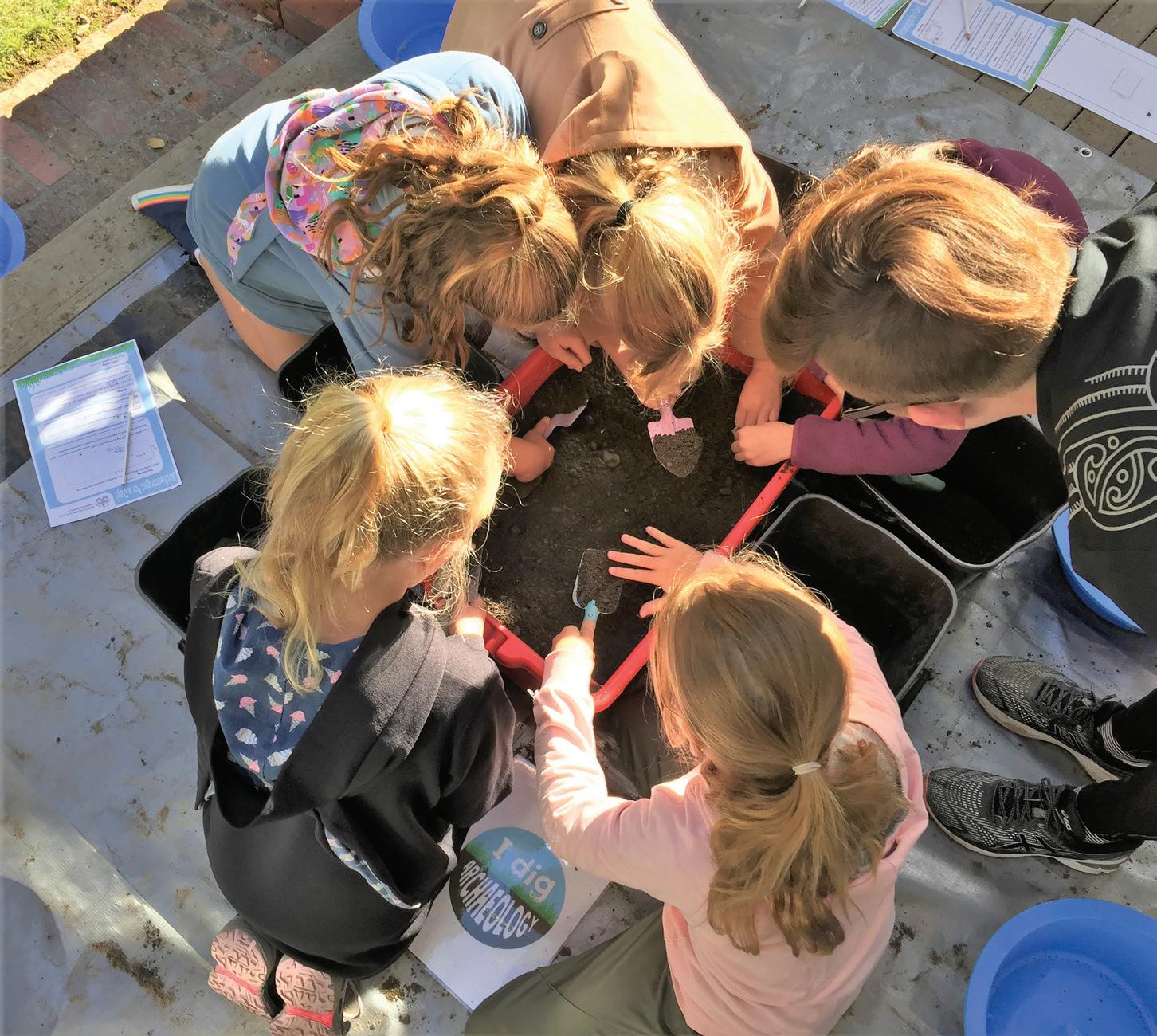
NGAHURU • AUTUMN 2023 6 Heritage Quarterly
An archaeologist for the day, a previous Archaeology Week event in Christchurch.
ARCHAEOLOGY WEEK
Maritime archaeology making a splash
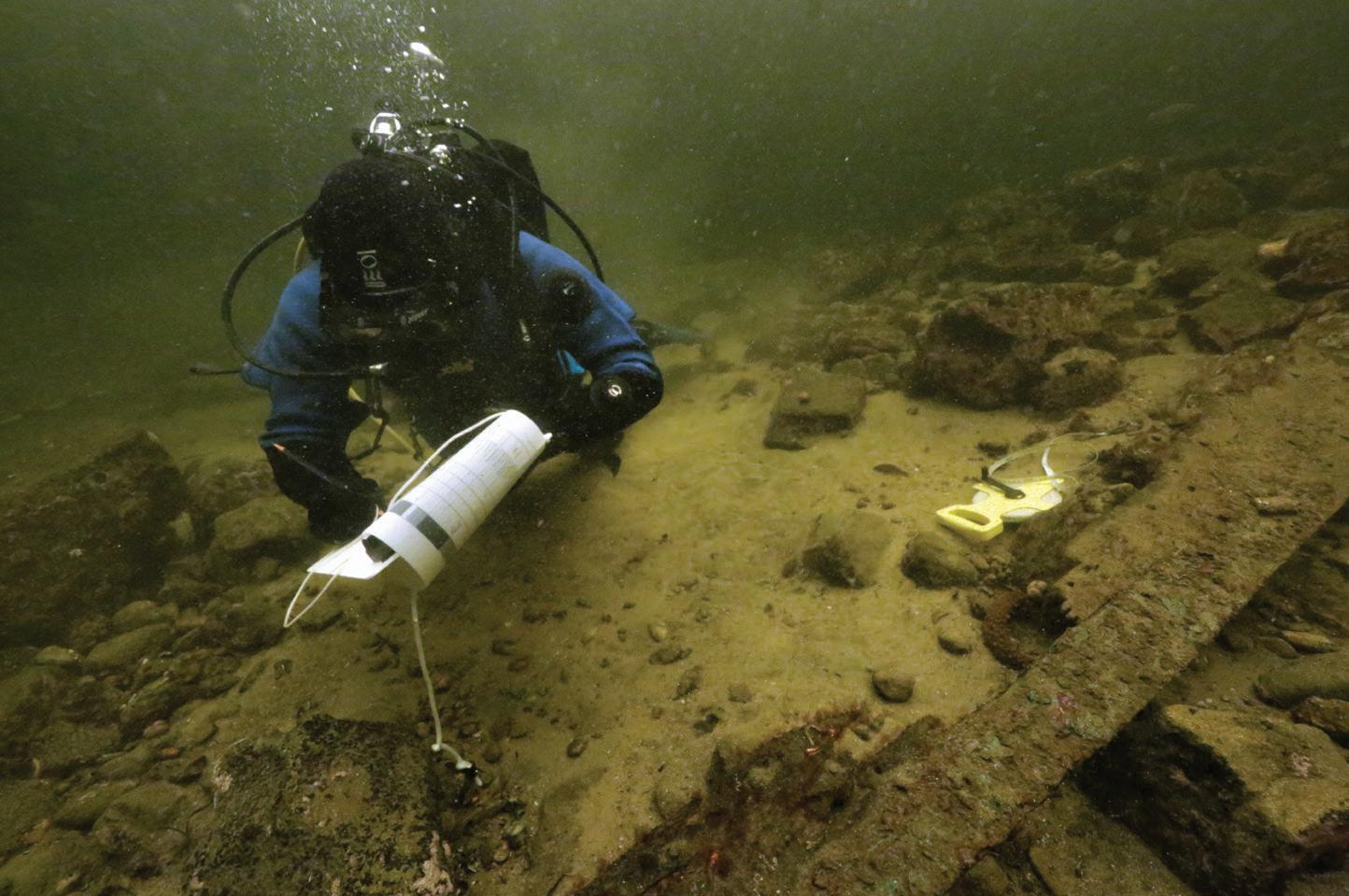
won the New Zealand Archaeology Association’s Public Archaeology Award in 2022.
Pam Bain, Director Regional Services for Heritage New Zealand Pouhere Taonga, hopes the new podcast episodes will be a popular addition to the Aotearoa Unearthed podcast. “This podcast is a great resource for New Zealanders interested in our nation’s history and archaeology. We are also often amazed to see the international reach. Over a thousand downloads have come from outside New Zealand. There are listeners from America, Asia, Australia, United Kingdom, the Middle East and Europe.” Opportunities to educate New Zealanders about maritime archaeology are available through successful citizen science project GIRT (Gathering Information via Recreational and Technical) Scientific Divers courses, which were run recently over summer.
Both episodes feature Dr Kurt Bennett, Archaeologist for Heritage New Zealand Pouhere Taonga Auckland office. Kurt moved to Australia to do an MA and PhD in Maritime Archaeology from Flinders University in Adelaide. Now back in New Zealand, he is passionate about promoting maritime archaeology.
In the first episode, Kurt shares some of the incredible projects he has worked on in New Zealand: investigating the first New Zealand European shipwreck, Endeavour, in Fiordland, surveying the site of Cook’s landing at Pickersgill Harbour, and researching the ships’ graveyard on Rangitoto Island. He also outlines the state of maritime archaeology in New Zealand and the techniques and skills needed by maritime archaeologists.
Kurt believes maritime archaeology is so important to understanding New Zealand’s history. “We are an island nation. Before the arrival of commercial
air travel, all of our economy, migration and interaction with the world was based on shipping and voyaging. There is so much to learn from maritime archaeological sites, such as shipwrecks.”
The second episode highlights the public archaeology project on the wreck of HMS Buffalo in Whitianga. Kurt, together with Whitianga Museum/Mercury Bay Museum curator Rebecca Cox and maritime archaeologist Matthew Gainsford, led a project in 2021 which worked with recreational divers to conduct fieldwork on the shipwreck in Mercury Bay.
Educational programmes for local schools, where kids pretended to be underwater archaeologists by completing tasks in a school hall, and simulating moving about by lying on skateboards, were a hit. Public talks, museum exhibits and collaboration with Ngāti Hei have all led to a much wider community knowledge about the importance of the HMS Buffalo shipwreck. The team’s contribution was recognised when they
Kurt says, ‘These courses that we support are fantastic, and really help the participating recreational divers understand underwater cultural heritage sites, and the factors that drive their conservation or deterioration.” n
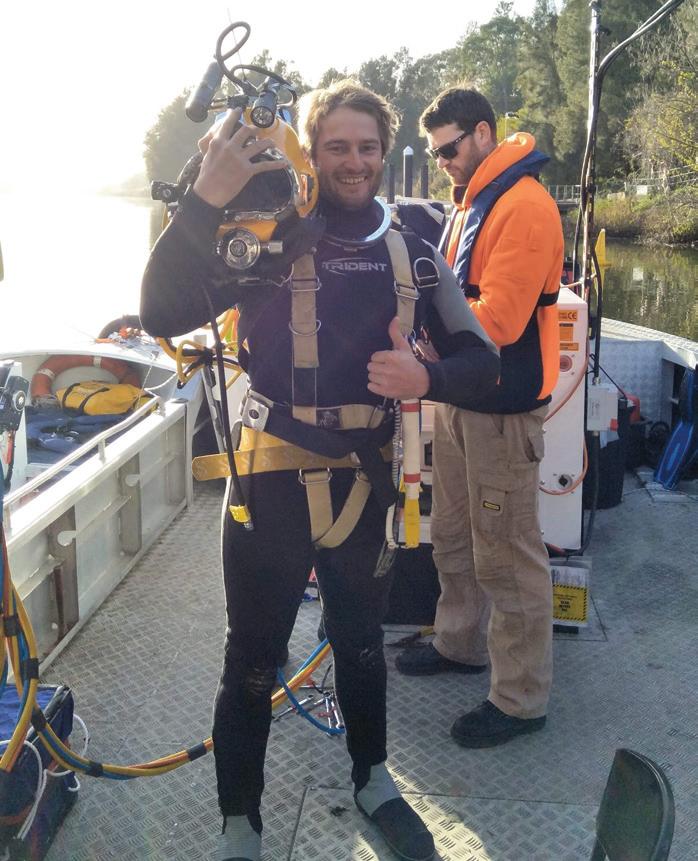
NGAHURU • AUTUMN 2023 7 Heritage Quarterly
WORDS: Rosemary Baird IMAGES: Dr Matthew Carter, Major Projects Foundation, and Heritage New Zealand Pouhere Taonga
Two new episodes of the Aotearoa Unearthed podcast highlight the increasing interest in maritime archaeology in New Zealand.
Kurt recording the Endeavour shipwreck in Fiordland. Photo: Dr Matthew Carter, Major Projects Foundation
Dr Kurt Bennett preparing for a dive.
ARCHAEOLOGY PODCAST
Photo: Heritage New Zealand Pouhere Taonga
Suffrage Memorial recognised with listing
WORDS: Anthony Phillips IMAGES: Heritage New Zealand Pouhere Taonga
One of a few memorials commemorating the suffrage movement in Aotearoa New Zealand, the Auckland Women’s Suffrage Memorial, has been listed as a Category 1 historic place.
Located in Auckland’s city centre, in the former Lower Khartoum Place, the Auckland Women’s Suffrage Memorial was created in 1993 to commemorate the centenary of women’s suffrage in Aotearoa New Zealand. Forming part of a busy pedestrian through-way connecting Kitchener and Lorne Streets, the Memorial’s steps offer an easy transition from the heart of the city to the Auckland Art Gallery and Albert Park.
The Memorial is significant for its close association with the wider women’s movement in Aotearoa New Zealand and in particular the National Council of Women New Zealand (NCWNZ).
The NCWNZ become notable as one of the most influential women’s
organisations during the 20th century and led the push to further women’s rights beyond suffrage reform. The 1960s and 1970s saw a rise of secondwave feminism with a renewed focus on advocacy and awareness for women’s issues across mainstream society. Campaigns advocating for equal pay and employment, equal rights and maternity leave, were areas of focus for the organisation which led to a dramatic improvement in women’s participation in areas such as employment and tertiary education.
The commemoration of Suffrage Day started in 1971. Stemming from advocacy led by the Auckland Women’s Liberation Front (AWLF) with the intention of raising the profile of women’s history, they were
successful in the development of an annual event. Leading into the 1990s and the centenary of women’s suffrage, the 1993 Suffrage Centennial Trust/Whakatū Wahine was established to contribute to commemorations that would promote public understanding and education of suffrage year. Nearly 100 years since women were enfranchised and the progress that was achieved on behalf of women in Aotearoa New Zealand, there were few public memorials marking these significant social advances across the country.
Artist Jan Morrison proposed the creation of a mural commemorating the suffrage centenary and approached the Centennial Year Trust/Whakatū Wahine and then Auckland City Council to secure funding.
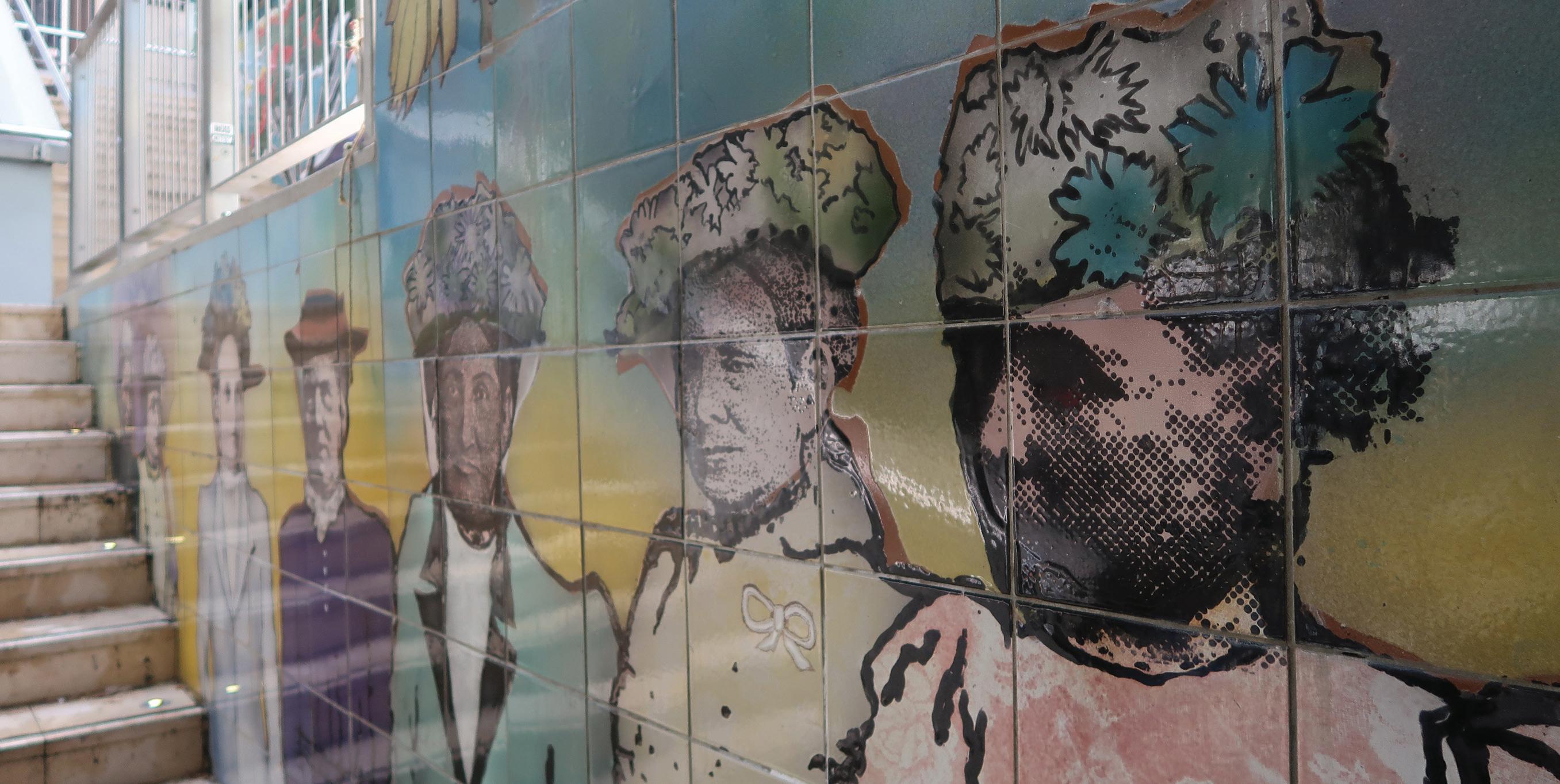
NGAHURU • AUTUMN 2023 8 Heritage Quarterly AUCKLAND
The Auckland Women's Suffrage Memorial, showing key figures of the movement.
After considering a series of locations such as the Ellen Melville Hall, Khartoum Place as it was then known, was selected. Morrison engaged fellow artist Clauida Pond-Eyley to collaborate with her on the project, both of whom had artistic backgrounds centred in environmental and human rights activism. Pond-Eyley’s work had a strong focus on feminist perspectives.
Morrison and Pond-Eyley set about creating a series of hand-crafted panels of over 2,000 ceramic tiles which would front the existing cascading water feature. With bold colour palettes, the design embraced the three-dimensional space of the water feature in a wraparound mural that people can experience as they walk through. The process of creating the tiles included airbrushing glazes before firing and slip-trailing and silk-screening processes achieving the stencil transfer of the images. Remarkably, this mural is understood to be the first time all three processes were combined on an installation of this scale and in a public art space.
The mural depicts the struggles of women and highlights the significant historical achievements and progress of the suffragists. The mural prominently displays the 1893 petition, depicted as a scroll, across the fountain pools and includes flax kete to represent the weaving of two cultures.
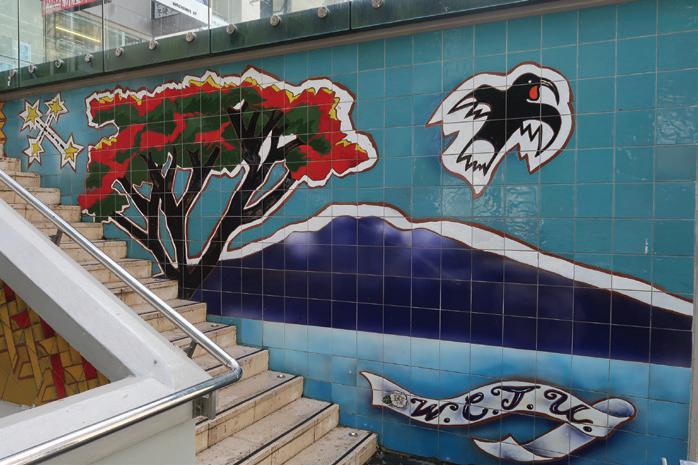
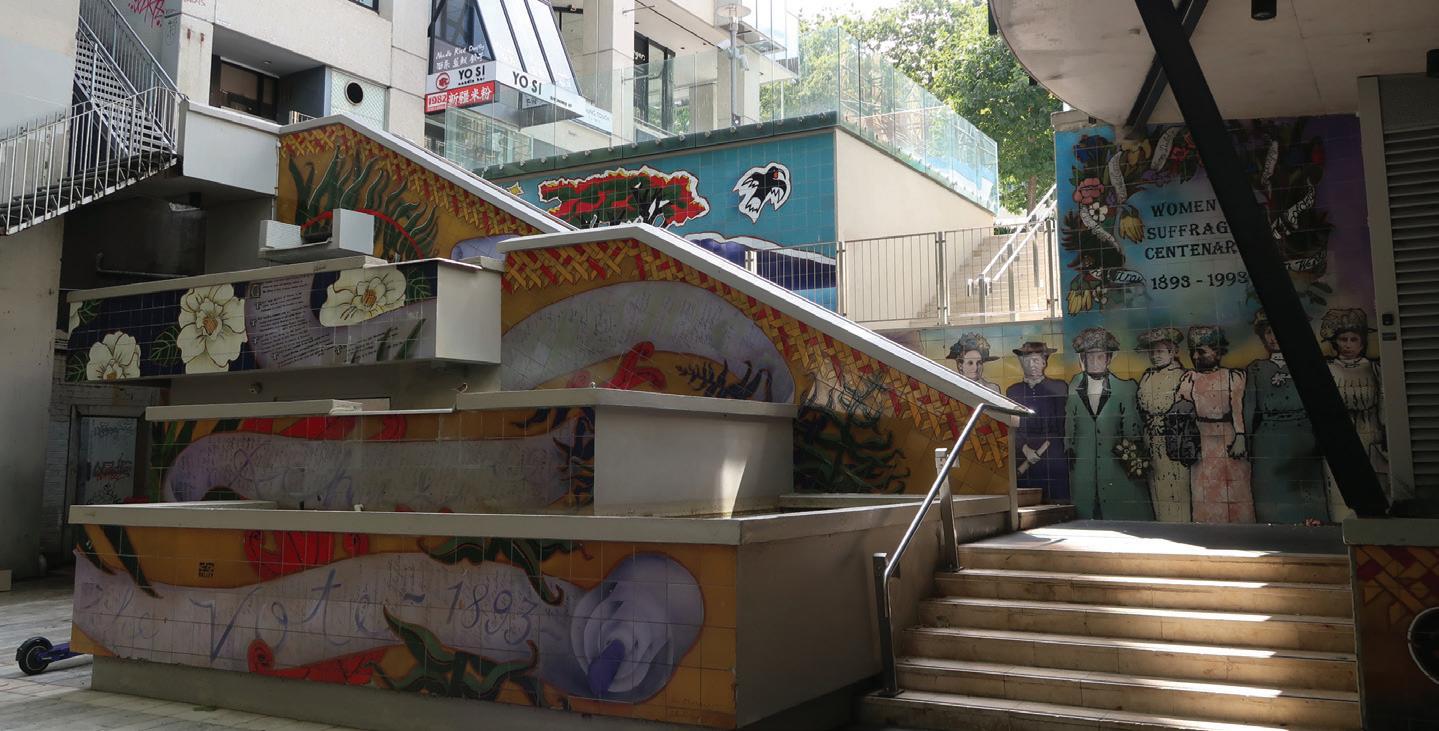
Prominent suffrage individuals featured include:
• Amey Daldy, president of the Auckland Women’s Franchise League (AWFL) who went on to be a driving force forming the NCWNZ and served as its president in 1898.
• Anne Ward, the first President of the Women’s Christian Temperance Union (WCTU).
• Lizzy Rattray, one of the earliest women journalists, an elected member of the AWFL and one of the suffragists who presented the 1893 petition to the House of Representatives.
• Elizabeth Yates, first woman mayor in the British Empire.
• Annie Schnackenberg, who was a founding member and president of the WCTU (1891–1897) and a founding member of NCWNZ.
Also depicted are Matilda Allsopp and Fanny Brown, two of the first seven women enrolled to vote in Aotearoa New Zealand, and Ada Wells suffragist and first national secretary of NCWNZ, among others.
The Memorial also honours suffragist campaigner Meri Te Tai Mangakāhia of Te Rarawa who was the first recorded woman to address Te Kotahitanga Parliament, an autonomous Māori parliament that convened annually between 1892 and 1902.
Sitting prominently, a separate section of the mural depicts four women with bicycles. The inclusion of the humble bicycle as part of the mural is symbolic and represents the part bicycles played in empowering suffragists to gather petition signatures in outlying areas. This section of the mural was added some weeks after the mural was unveiled.
In 1993, as part of the centenary commemorations and in keeping with the theme of empowering future generations of women, the Auckland
Women’s Suffrage Memorial was officially unveiled by President Mary Robinson of the Republic of Island and then Governor General, Dame Cath Tizard. The occasion was particularly significant as both Robinson and Tizard were the first women to hold their respective offices with Dame Cath also being the first woman Mayor of Auckland (1983-1990). Many attended the celebration including descendants of Meri Te Tai Mangakāhia. In recent years, there have been attempts to remove the suffrage memorial and develop the site. The cultural commentariat of Auckland offered many views and perspectives on both sides, enthusiastic to have it both retained or moved. Such attempts drew fierce opposition from various parts of Auckland society, including the NCWNZ and Zonta NZ. The campaign to protect the memorial made a significant achievement in 2016 when Auckland Council scheduled the memorial as a historic place under the Auckland Unitary Plan. That same year, the Waitematā Local Board renamed Lower Khartoum Place as Te Hā o Hine Place, a name gifted by Ngāti Whātua Ōrākei and derived from the Māori proverb ‘Me aro koe ki te hā o Hineahu-one’ translating to ‘pay heed to the dignity of women’.
The recent listing of the Auckland Women’s Suffrage Memorial by Heritage New Zealand Pouhere Taonga recognises the significant contributions these pioneering women have made to our national identity and social and political history. The listing also recognises the 21st century advocacy of a new generation of Auckland women who campaigned for the Memorial’s recognition and protection. As a result of this outcome future generations of New Zealanders will be exposed to its educational learnings and artistic values. n
NGAHURU • AUTUMN 2023 9 Heritage Quarterly
AUCKLAND
The memorial as seen from Lorne Street.
Memorial detail acknowledging the Women's Christian Temperance Union.
Grandstanding in Taihape
WORDS: David Watt IMAGES: Heritage New Zealand Pouhere Taonga and Bernie Lee Photography
No-one could be more pleased than the Chief Executive of Heritage New Zealand Pouhere Taonga, Andrew Coleman, when the Board recently listed the Taihape Memorial Park Grandstand in the New Zealand Heritage List/Rārangi Kōrero as a Category 2 historic Place.
Born and bred in Taihape, Andrew sings the praises of his former old hometown at every opportunity, and why not as it has a proud history of achievements, for farming, for sporting legends, for its tourism, and as a stopping off point for travellers up and down the North Island.
For Andrew, the Memorial Park Grandstand and grounds of what he knew as the ‘Rec’ were a go-to place, as for many in the community of Taihape. “The grandstand was a sporting hub with rugby, cricket and athletics using it as the base for competitions and practice. The ‘Rec’ was also the sporting home for tennis and squash and used more broadly by the local primary school, now the region’s area school, the Agricultural and Pastoral Show, now known as Gumboot Day and the town’s swimming pool,” says Andrew.
Heritage New Zealand Pouhere Taonga staff were pleased to receive an application from the Taihape Heritage Trust for the Memorial Park Grandstand. The Trust has a history of working to
save listed buildings in the region, such as the town’s Category 2 heritage listed Majestic Theatre, with more on the horizon.
According to Taihape Heritage Trust’s Peter Kipling-Arthur, “The Trust is working to promote the preservation of other historic sites including the iconic Town Hall and Library, and to encourage both private owners and the Rangitikei District Council to extend heritage listing and protection to key buildings in the District Plan.”
The grandstand at Taihape Memorial Park on Kokako Street, built in 1924, reflects the development of sports and recreation in Aotearoa New Zealand during the late 19th and early 20th centuries. The grandstand is architecturally significant as a wellpreserved example of grandstand structures from its era and is considered an ‘icon’ to the 1800-strong population of Taihape.
Taihape is located in the heart of the Mōkai Pātea rohe which was first settled by Ngāti Hotu. The tangata whenua of Mōkai Pātea are Ngāti Tamakōpiri, Ngāi Te Ohuake, Ngāti Hauiti and
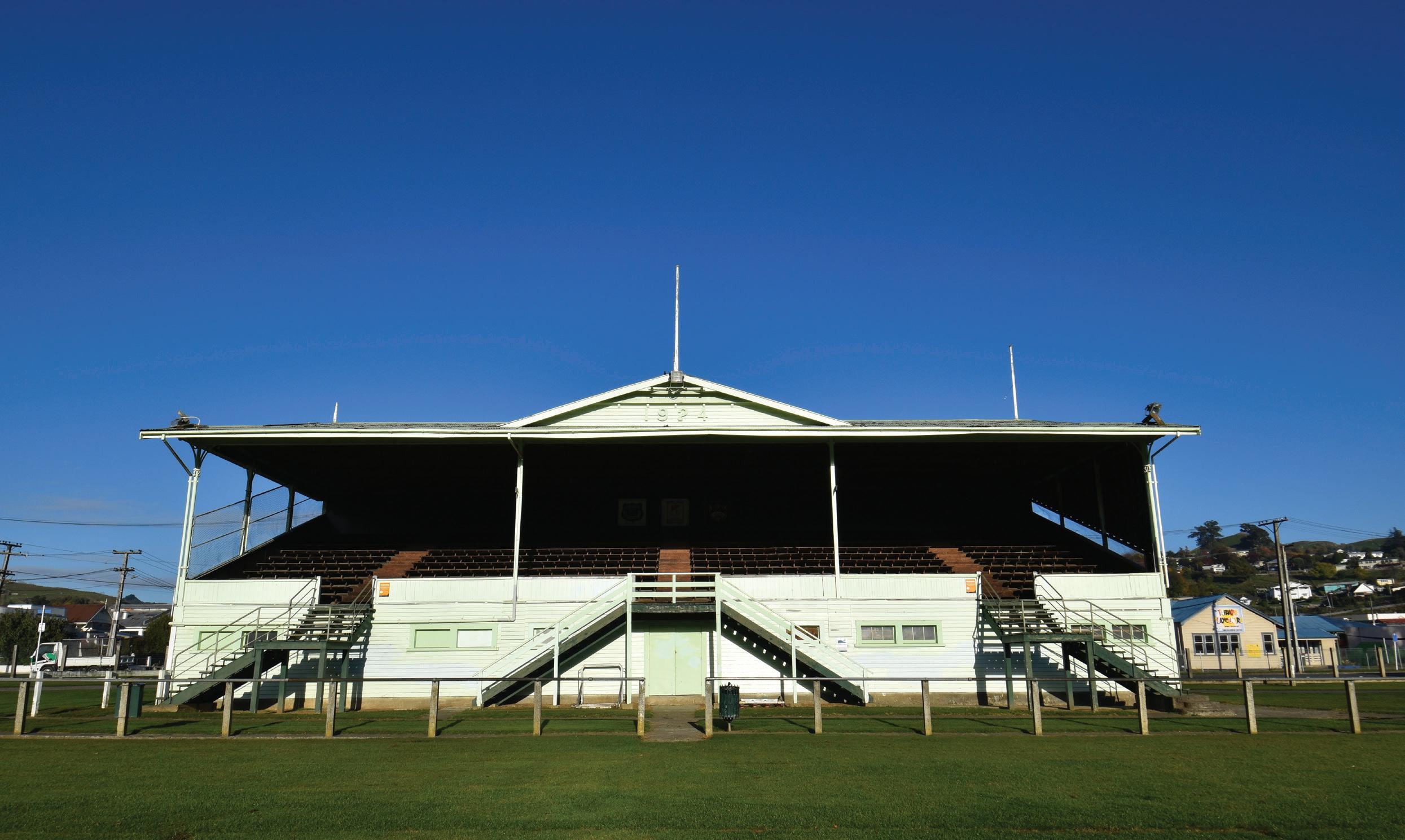
NGAHURU • AUTUMN 2023 10 Heritage Quarterly TAIHAPE
The 1924 Taihape Memorial Park Grandstand. Photo: Heritage New Zealand Pouhere Taonga
Ngāti Whitikaupeka, who all trace their whakapapa back to the son of celebrated explorer Tamatea Pōkai Whenua of the Tākitimu waka.
In the late 1860s the first Pākehā arrived to settle in the northern part of the rohe, where they took up sheep runs after negotiating private leases on land.
Taihape, originally named Hautapu after the Hautapu river, and then as Otaihape after the Otaihape stream was little more than a rough clearing in dense native bush, but by the end of 1897 extensive bush clearance had been undertaken. The ‘O' was dropped from the name and ‘Taihape’ was developing into a fledgling township. It included a large recreation reserve which became more commonly known as the ‘Oval Domain’ following improvements in the early 20th century.
A grandstand had long been proposed at
the ‘Oval Domain’ and was at one stage suggested as a fitting WWI memorial for the town, but this did not come to fruition. A working bee comprising local residents and the ‘enthusiastic’ athletics club began felling bush in 1898, and the land was formally declared a recreational reserve in February 1899. The grandstand was erected in 1924 after the Taihape Borough Council sought plans and specifications as part of further ground improvements.
The Rangitīkei Agricultural and Pastoral Association was reportedly the first organised body to use the grandstand during their annual show in January 1925, with many groups and associations making use of it over the years, and it has been the venue for numerous civic events.
The grandstand has a close connection with local rugby clubs – the Taihape Rugby and Sports Club and Utiku & Old

Boys Rugby Football Club. Spectators have filled the grandstand with players utilising the facilities below.
There have been changes to the grandstand over the years, most of which relate to the ground floor interior, but the impressive building largely retains its exterior form.
The future of the grandstand is being investigated, and anticipated strengthening works and community support will help ensure its preservation for future generations to enjoy.
Peter Kipling-Arthur's passion for Taihape’s past and future is clear, “Taihape is a microcosm of small-town architecture and has shown changes in style over the last 130 years. This recognition of the grandstand will help preserve the heart of rural New Zealand.” n
TAIHAPE
The park is still in use with rugby one of the sports played there. Photo: Bernie Lee Photography
Important story told at new Tohu Whenua site
WORDS AND IMAGES: Caroline Toplis and Jose Watson
The newest Tohu Whenua site has been welcomed to the programme in an event that celebrated its importance to both iwi and the community.
Te Kopikopiko o te Waka is the newest site to become part of the Tohu Whenua network and marks an important milestone for the programme of significant stories being told in a landscape setting.
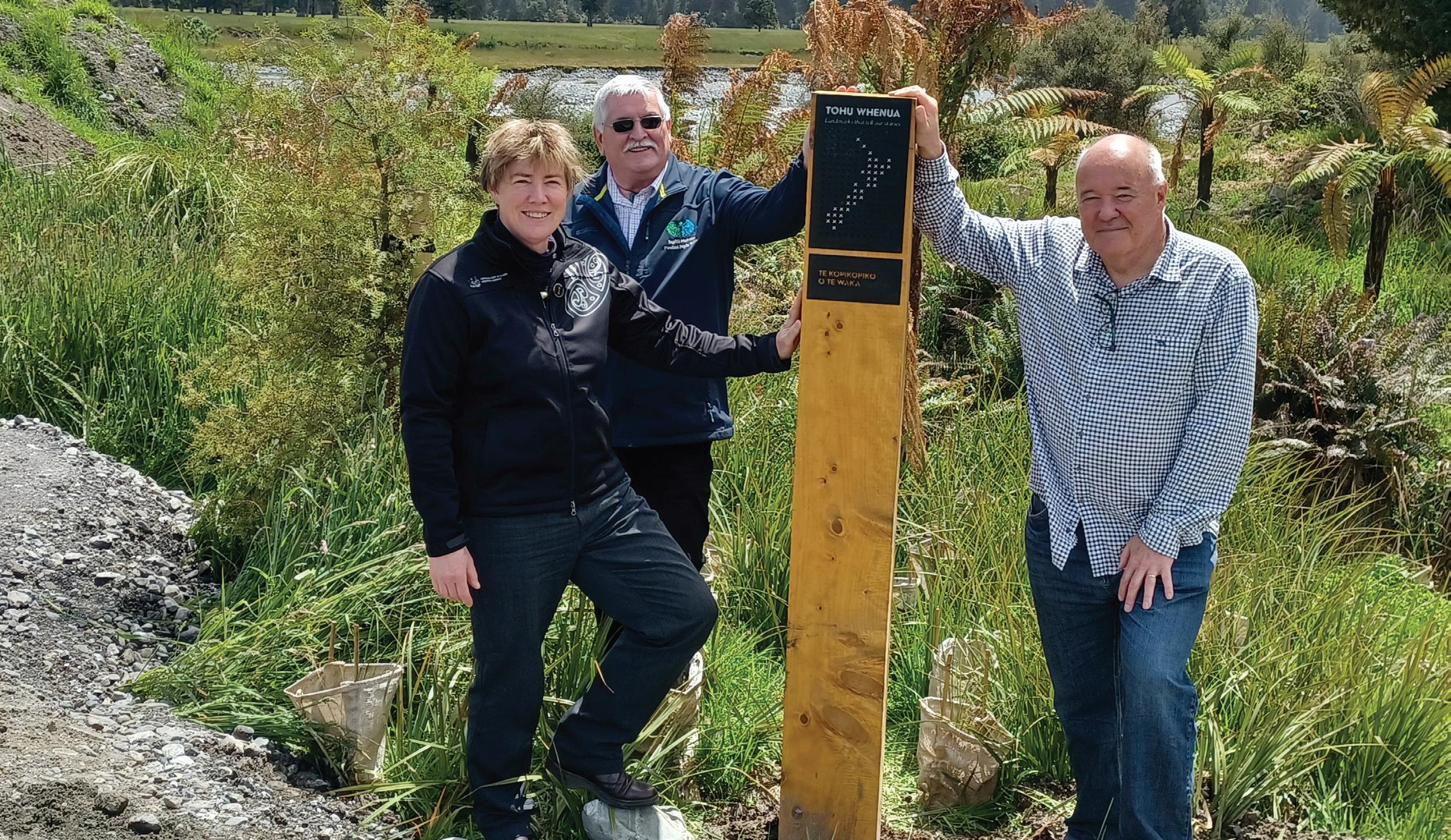
The site tells the story of Aoraki and his brothers frozen in time, and the creation of Te Wai Pounamu (the South Island), represented by the mountain peaks visible from the site.
Managed by the Department of Conservation Te Papa Atawhai and situated 9km west of Fox Glacier, on the
West Coast of the South Island, the site has been presented for visitors for some time as ‘Peak View’, where people can gain a vantage point of Te Moeka o Tuawe (Fox Glacier) framed by Kā Tiritiri o te Moana (the Southern Alps).
The redeveloped site celebrates and showcases the connection of mana whenua with the landscapes of Te Tonga ki te Tai o Poutini (South Westland). Co-designed with Ngāti Mahaki, it features cultural design elements and is landscaped with a central waka feature to present the whakapapa of mana whenua and the overarching storyline of
Te Kopikopiko o te Waka (the capsized canoe).
The programme name ‘Tohu Whenua’ acknowledges memories of the land, marking places made significant by our forebears and telling their stories. Literally it translates as ‘land mark’ and Te Kopikopiko o te Waka is literally a land mark, and much more. It refers to Aotearoa New Zealand’s very foundations and is a truly mana whenua story – of whakapapa, of tribal – and national –identity, of the environment, and of the connection between then and now.
NGAHURU • AUTUMN 2023 12 Heritage Quarterly AORAKI
Nic Jackson Heritage New Zealand Pouhere Taonga, Paul Madgwick Te Rūnanga o Makaawhio, Mark Davies Department of Conservation.
Photo: Jose Watson
Tohu Whenua Governance Group Chair Andrew Coleman says the inclusion of Te Kopikopiko o te Waka in Tohu Whenua represents significant growth for the programme. “It will be the first site added that is landscape based and it speaks to the very origins of storytelling in Aotearoa New Zealand. What is different about this place compared with the other sites in the programme so far is that it is not a building nor a story of industrial heritage. All history is important and that is why we do what we do but a place like this takes history and storytelling to a whole other level and we are very proud to take this next step in the programme’s development, showing our commitment to celebrating and sharing our nation’s whole history. We hope it will be the first of many similar places to become a Tohu Whenua.”
Te Kopikopiko o te Waka was opened and launched as a Tohu Whenua site in a ceremony on 10 December 2022, attended by representatives from Te Rūnanga o Makaawhio, the Department of Conservation Te Papa Atawhai and Heritage New Zealand Pouhere Taonga, as well as the Westland District mayor, councillors, tourist operators and members of the South Westland community. Development of the Te Kopikopiko o te Waka site was prioritised following the 2019 flood that washed away the State Highway 6 bridge, dislodged tonnes of rubbish down Fox River and destroyed access to the Fox Glacier Valley. n
The Story
In the beginning there was no Te Wai Pounamu or Aotearoa. The waters of kiwa rolled over the place now occupied by the South Island, the North Island and Stewart Island. No sign of land existed. Raki (the Sky Father) wedded Papa-tūā-nuku (the Earth Mother). After the marriage, some of the Sky Children came down to greet their father's new wife.
Among the celestial visitors were four sons of Raki who were named Ao-raki (Cloud in the Sky), Raki-roa (Long Raki), Raki-rua (Raki the Second) and Rarakiroa (Long Unbroken Line). They came down in a canoe which was known as Te Waka o Aoraki. They cruised around the vast ocean looking for Papa-tūā-nuku, but could not find land. They decided to return to their celestial home, but the karakia (incantation) which should have lifted the waka (canoe) back to the
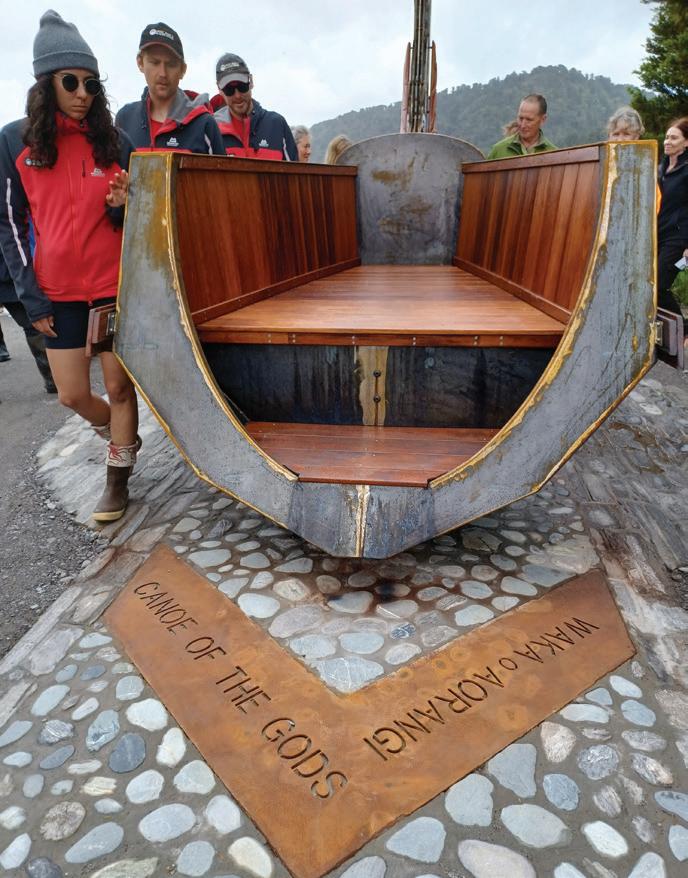
heavens failed and the canoe fell back into the sea and turned over onto its side, turning to stone and earth in the process. The waka listed and settled with the west side much higher out of the water than the east. Thus the whole waka formed the South Island, hence the name: Te Waka o Aoraki. Aoraki and his brothers clambered on to the high side and were turned to stone. They are still there today. Aoraki is the highest peak (also known as Mount Cook) and his brothers are the next highest peaks near him – Rakiroa (Mount Dampier), Rakirua (Mount Teichelmann) and Rarakiroa (Mount Tasman).
For Ngāi Tahu, traditions such as this represent the links between the cosmological world of the gods and present generations. These histories reinforce tribal identity and solidarity, and document the events which shaped the environment of Te Wai Pounamu and Ngāi Tahu as iwi.
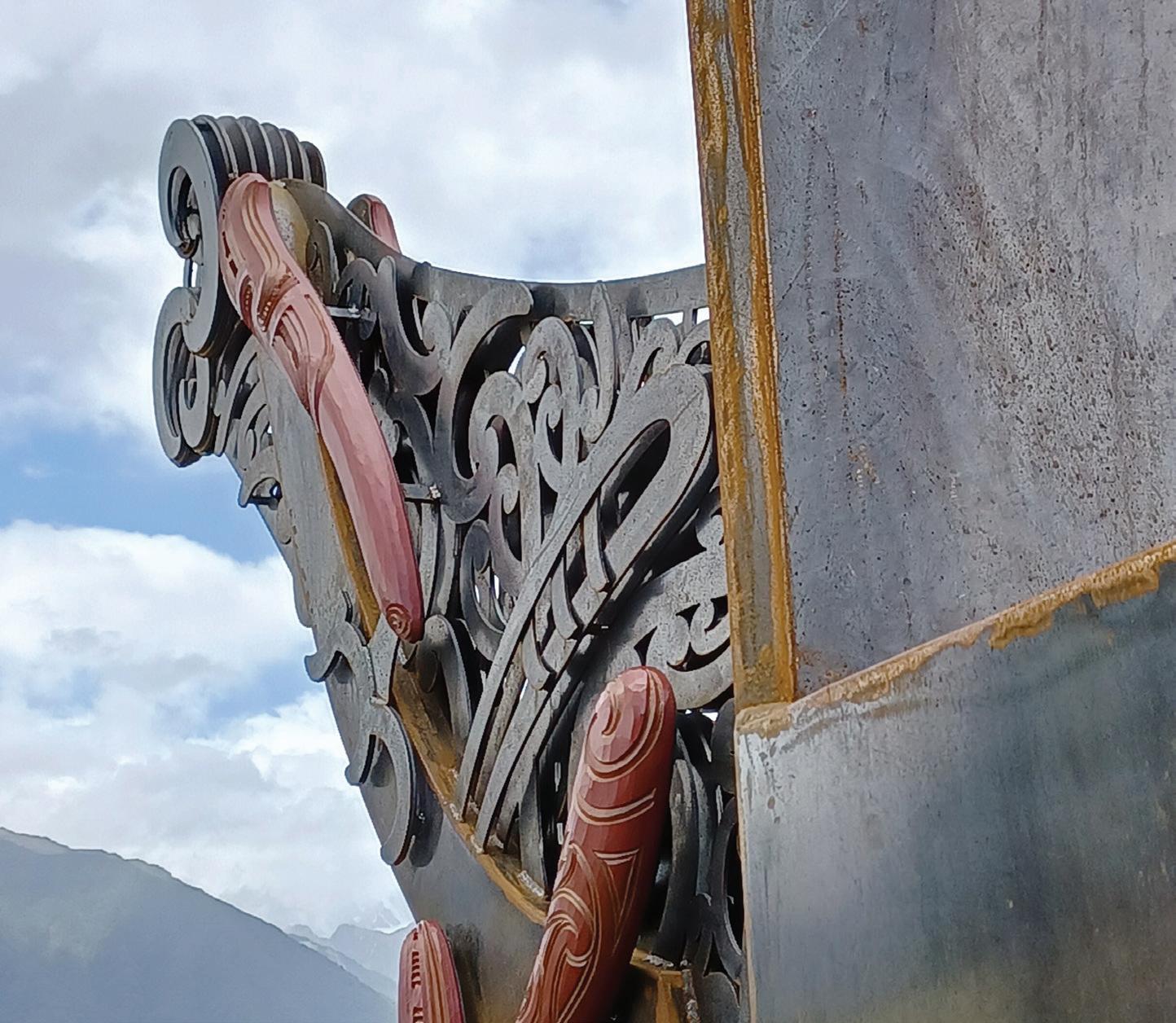
NGAHURU • AUTUMN 2023 13 Heritage Quarterly
The story of the four sons of Raki is one of how Te Wai Pounamu (the South Island) came to be.
Heritage New Zealand Pouhere Taonga is a partner in Tohu Whenua, a visitor programme that connects New Zealanders with our unique heritage. Learn more at www. tohuwhenua.nz or follow us on social media Facebook and Instagram @tohuwhenua
of Te Kopikopiko o te Waka
Te Kopikopiko o te Waka bow. Photo: Caroline Toplis
AORAKI
Pīhopa Richard Wallace Bishop blesses Te Kopikopiko o te Waka. Photo: Caroline Toplis
Many ways to remember this Anzac Day
The 80th anniversary of a major WWII battle for the Allied Forces in the Middle East, where large-scale offensives to push back German and Italian armies occured, will be recognised in 2023 as Anzac Day services return to normal.
In March 1943, at the Battle of Medenine in Tunisia, German Field Marshal Edwin Rommel fought his last major encounter in Africa as Axis forces attempted to delay an attack by the British 8th Army on the Mareth Line.
The war in the Middle East was changing fast, and with the Battle of Medenine going in favour to the Allies, Rommel’s forces and the remaining Italian army found themselves squeezed into a corner
of Tunisia and then retreating towards Italy. Following April 1943 Allied forces would be focusing their efforts on the invasion of Sicily and the Italian mainland.
Observers at of Anzac Day in 1943 would have seen hopeful indications that the tide of war was changing, and not just in the Middle East and Europe. Naval forces in the Pacific, with significant air combat support, were turning the tide on Japanese occupancy. Guadacanal
Island was cleared of Japanese troops in February, and Allied forces steadily moved on recapturing islands and other territory under Japanese occupation.
Back in New Zealand, families were praying and hoping their loved ones away at war would get back soon. Anzac Day services up and down New Zealand had an increasing sense of hope, but the war effort was far from ended against our main enemies, Germany and Japan. The
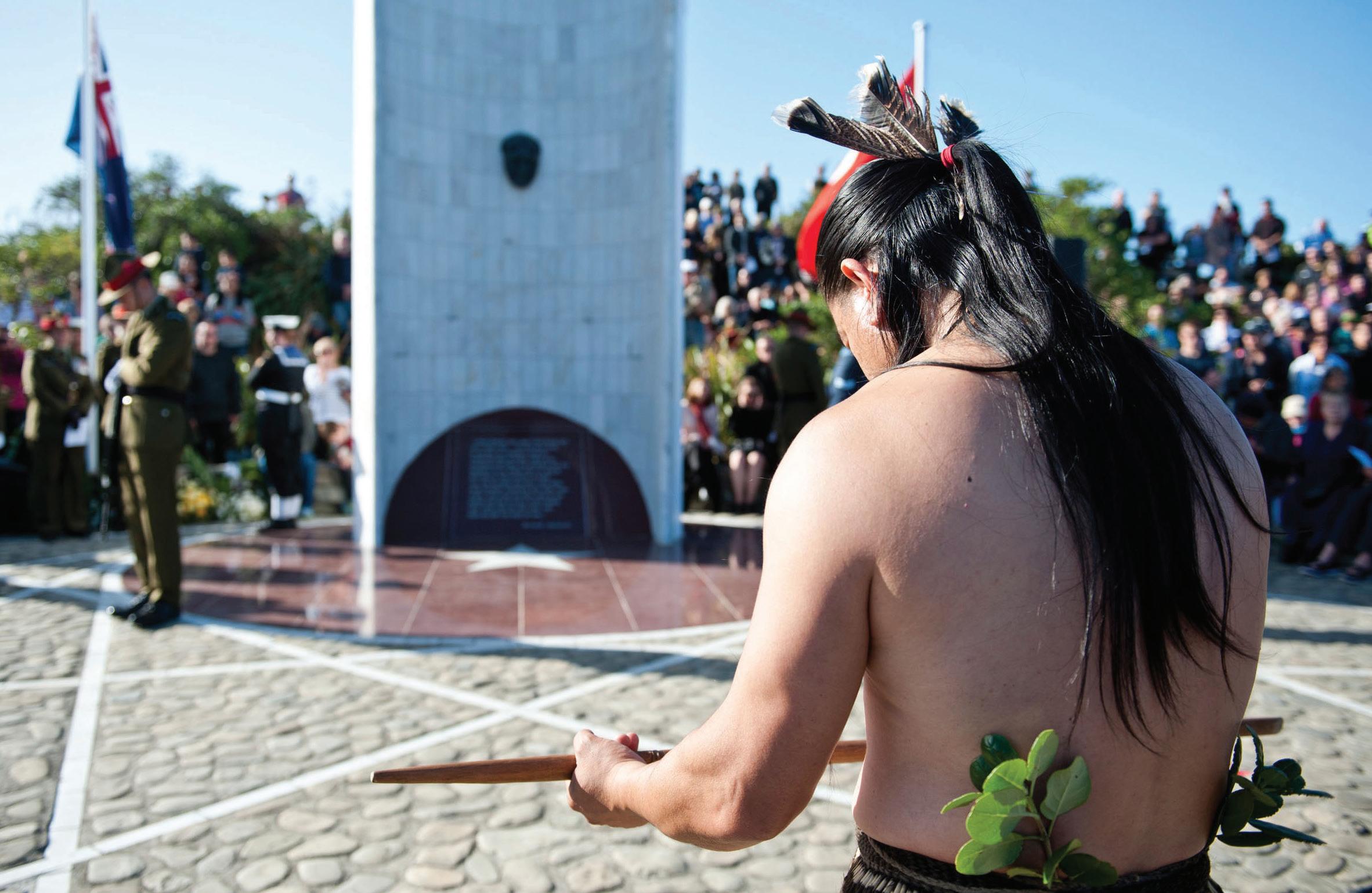
NGAHURU • AUTUMN 2023 14 Heritage Quarterly ANZAC DAY
WORDS: David Watt IMAGES: Manatū Taonga, Heritage New Zealand Pouhere Taonga and RNZRSA
Anzac Day commemorations at Wellington's south coast Ataturk Memorial Park.
Photo: Manatū Taonga
war still had two hard years to go, with many more Kiwi lives lost in combat.
Anzac Day in New Zealand has been marked by services throughout the country since 1916 during WWI. The first Anzac Day was observed as a half day holiday on 25 April 1916, to mark the first anniversary of the Gallipoli landings. The mood was solemn, weekend racing was postponed and cinemas stayed shut around the country until late afternoon. The first Anzac memorial built in New Zealand was a wooden cross erected in 1916 on top of Tīnui Taipo/Mount Maunsell in the Wairarapa. Over the years since this memorial was established it has been a long tradition for locals to climb up to the cross at Tīnui to commemorate those who came from the area and lost their lives in war.
A special walkway was created some years ago through the Tīnui Forest Park and a neighbouring farm to enable people to reach the track up to the Anzac memorial. This access route has been an amazing community initiative and a credit to the perseverance of a small group of local people to keep Anzac Day a special part of Tīnui’s heritage.
Parewanui, near Bulls in the Rangitīkei District, sees a special gathering on Anzac Day to pay tribute to a famous horse, Bess, who survived WWI, one of only four horses to return at war’s end. As one of more than 10,000 horses that New Zealand sent overseas to serve in WWI.
Bess was ridden in the Middle East and on the Western Front by Lieutenant Colonel Charles Guy Powles, father of former New Zealand diplomat, Sir Guy Powles.
The Category 1 heritage listed memorial to Bess is one of very few remembering the role of horses in war and it had a significant value to the soldiers who were unable to bring their horses home. The memorial to Bess where she located in the farm paddock where Bess spent her last days. The Anzac service at Parewanui attracts over 300 people each year.
Over the decades there have been few cancellations of Anzac services in New Zealand. In 1937, a number of services were cancelled due to the polio epidemic, and in 2017, 58 services in the Auckland area were cancelled or changed because of the heightened terror threat that followed the Christchurch massacre.
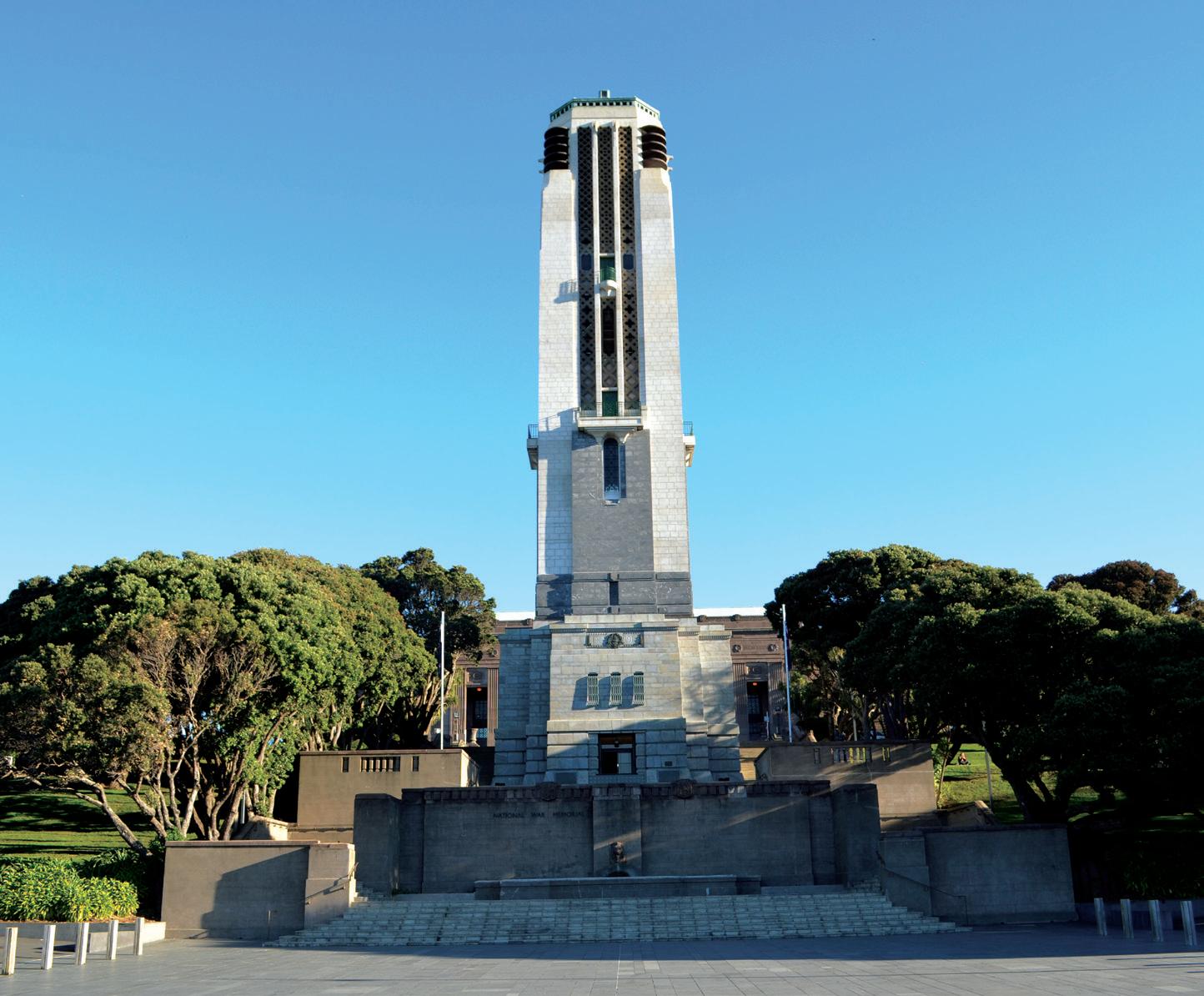
And for the first time in Anzac Day history we recall the nationwide cancellation of public services in 2020 due to the Covid-19 pandemic. Instead, we experienced a 6am virtual dawn service across the country, the first of its kind, with many chosing to stand at the end of their driveways in a dawn vigil.
With Anzac services returning to normal, thousands of people and families will
once again gather in remembrance of those who died serving their country in many theatres of war. We will expect that huge wave of interest to gather in all towns and cities throughout New Zealand in remembrance on 25 April 2023.
Sport has always been popular in the military, used for team building, fitness, recreation and morale, and 2023 will place special emphasis on this. Highly respected former All Black captain, Sir Wayne (Buck) Shelford, will be presiding at Anzac services for the first time, having recently taken over the mantle of National President of the Royal New Zealand Returned Services Association (RNZRSA) from former long serving President, B. J. Clark.
At the RNZRSA National Conference this past year ‘Buck’ Shelford was presented with the kākahu maumahara, the traditional cloak worn by RNZRSA National Presidents.
Sporting figures and others who admire ‘Buck’ Shelford leading the All Blacks to victory back in his day will be looking out for this new leader of our RNZRSA on Anzac Day and on other ceremonial occasions. n
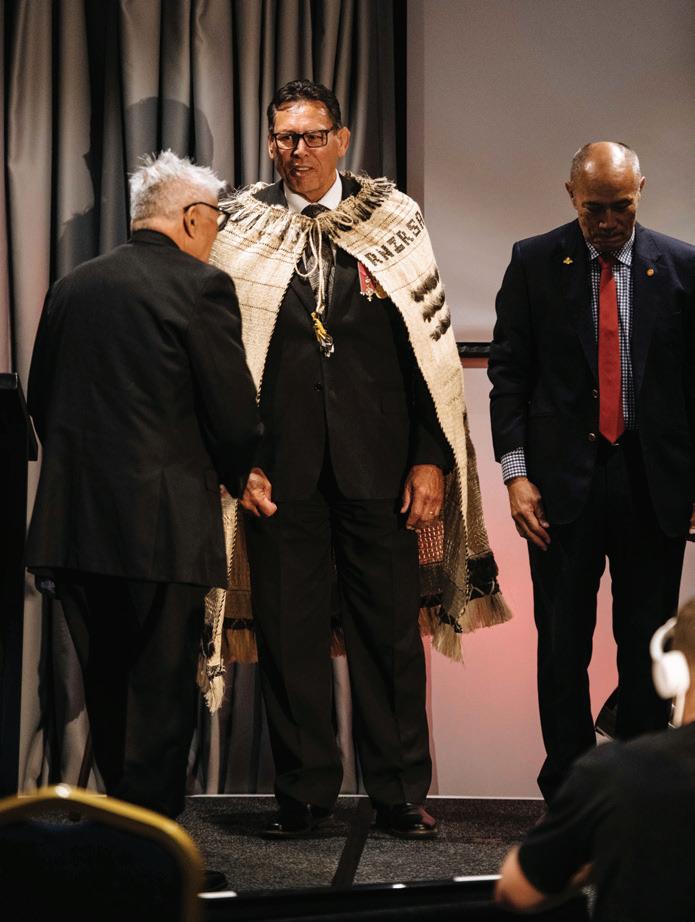
NGAHURU • AUTUMN 2023 15 Heritage Quarterly
Pukeahu National War Memorial Park. Photo: Heritage New Zealand Pouhere Taonga
ANZAC DAY
Newly appointed RNZRSA president Sir Wayne 'Buck' Shelford wearing the Kākahu Maumahara. Photo: RNZRSA
Fired up on mahi kōhatu
WORDS: Niki Partsch IMAGES: Heritage New Zealand Pouhere Taonga
The weather was cold, and rain was forecast, but the group that was gathered inside the marquee did not notice because they were on fire.
Over four days during October last year, a special gathering took place in Waimārama, Hawke's Bay. About 40 mātanga mahi kōhatu (practitioners of stonework) gathered to take part in a dedicated wānanga focused on mahi kōhatu, for creators who work with traditional stone tools and methods. They came from as far south as Invercargill and as far north as Kerikeri.
Huia Pacey, Pou Horanuku Ancestral Landscapes at Heritage New Zealand Pouhere Taonga, attended as a participant/kaimahi (helper). About the wānanga she says, “It was a rare opportunity for practitioners to get together to do mahi kōhatu, a very at-risk vulnerable mātauranga practice.”
Phil Belcher, an experienced educationalist and kaiwhakairo (carver), organised the wānanga. Phil does most of
his work using traditional stone tools. He was supported by his immediate whānau and many Waimārama locals during the wānanga. Funding for the wānanga came from the Heritage New Zealand Pouhere Taonga Mātauranga Māori programme pūtea (fund).
Huia described the organisation and planning for the event as “excellent”. All participants work in some way with stone tools. “There were some really experienced practitioners there and it was good for them to talk amongst themselves as peers,” says Huia.
Ages spread from late teens right up to those in their 80s, with a mixture of fulltime practitioners, tohunga (experts) and learners who all shared a strong focus on learning and sharing. “What was really funny, and indicative of the entire week was that after the pōwhiri, a quick visit
to the offsite Napier Museum collection and kai, we all headed to the marquee to set up workstations for the next day. But immediately everyone started mahi. They were so busy discussing and showing their projects, we completely missed the planned whakawhanaunga (getting to know each other) session because they just couldn’t wait to get started.”
The venue, Hinetemoa Health & Recreation Camp, was designed originally as an education facility but with a transformation underway is increasingly operating as a marae.
With appropriate permissions the group were able to collect hōanga (grinding stones) for their various projects. The sharing and learning continued as projects to work stone, pounamu and making other objects such as heru (hair combs) and fishing hooks got underway.
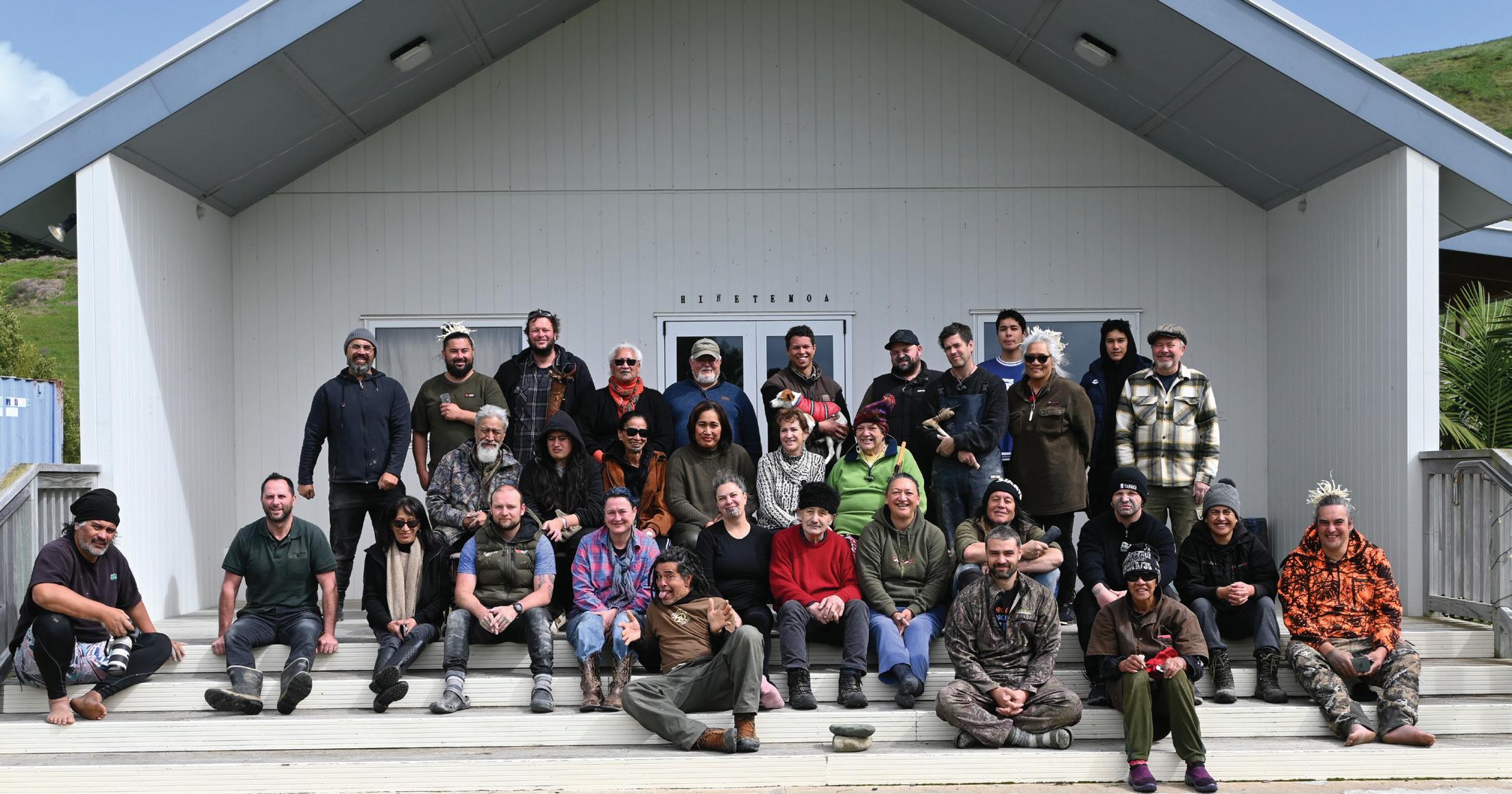
NGAHURU • AUTUMN 2023 16 Heritage Quarterly
WAIMĀRAMA
Wānanga participants outside Hinetemoa whare on the final day.
With advice from the two proficient kōauau (traditional flute) practitioners present, one participant carefully crafted a kōauau from bone, using stone tools.
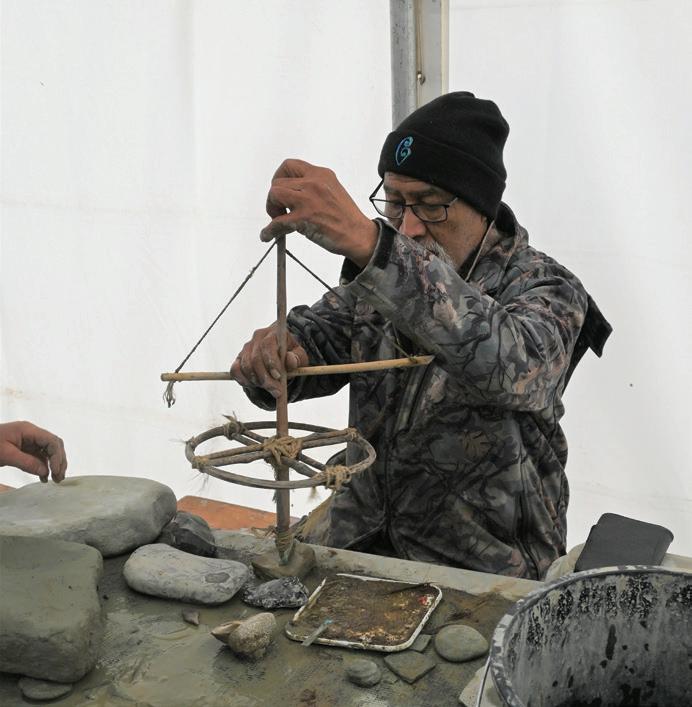

Dante Bonica, a nationally regarded pūkenga (specialist) of stone tools, participated. “Dante has had a lifelong passion for mahi kōhatu and was initiated into the practice as a young man under the guidance of Dame Te Atairangikaahu. He has over many years trained, advised and worked with so many practitioners that he is one of those pūkenga (specialists) pivotal to the mātauranga and continuity of this practice because of his passion and his willingness to share,” says Huia.

The marquee provided an excellent space to work outside during the cold spell. There was a large diesel heater and a couple of big comfortable couches which provided participants with space for collaboration and quiet discussions, including kaumātua Dante and Koro Te Whaiti.
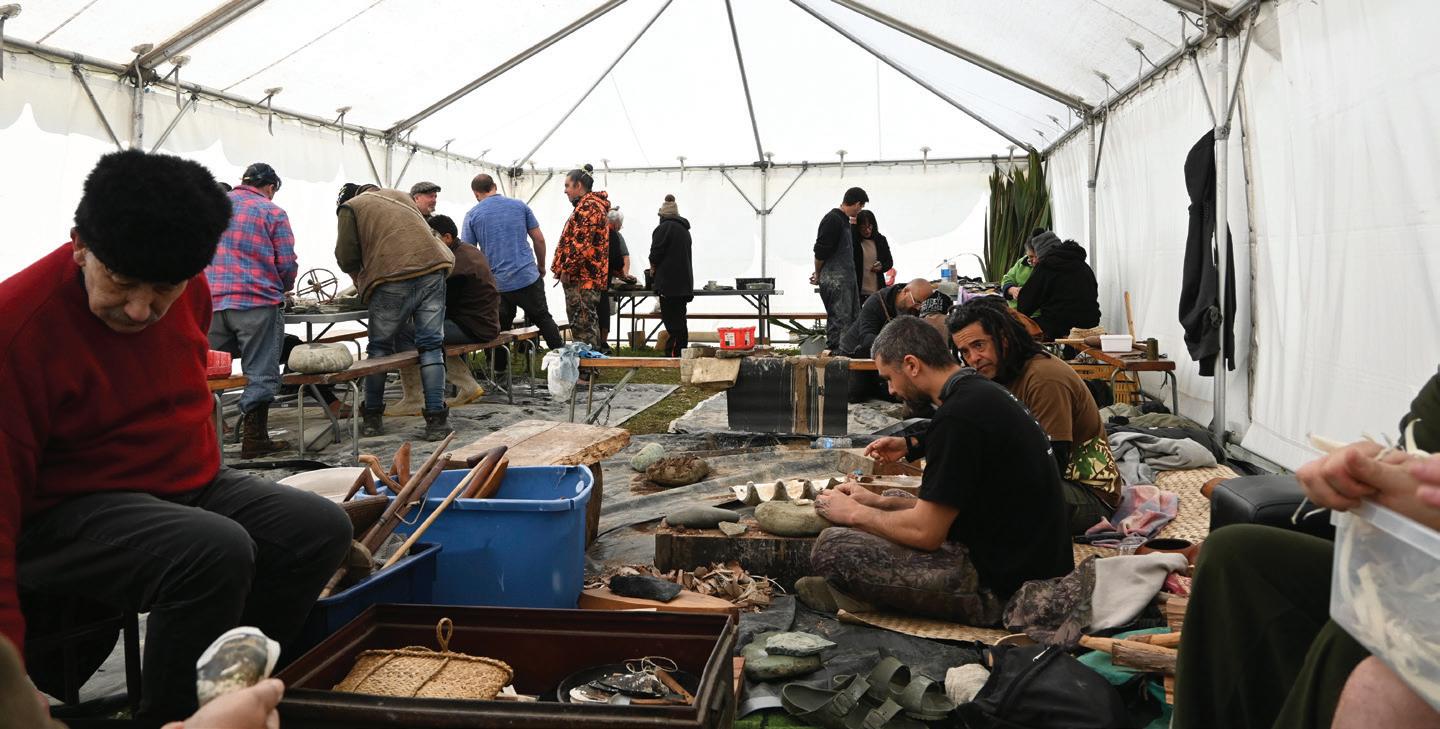
The rōpū (group) engineered tools to fashion new tools and then used the new tools to create an end product.
The earlier visit to Napier Museum offsite storage facility to view some taonga sparked various discussions on stonework techniques and about the knowledge contained within pūrākau (traditional stories) related to geological deposits
across Aotearoa. Over the course of the wānanga several participants were filmed and interviewed providing archival footage of this historic event.
Always present were the sounds of grinding and hammer dressing. Mahi was so intense and constant that even a power cut which took supply out of the whole valley went unnoticed. The group ate a cold lunch and happily used the hot water from a pot for tea and coffee because they were so focused on the mahi. “It didn’t faze them; it didn’t slow them down,” says Huia.
Feedback from participants was positive and all agreed on the value of their learnings. There was strong interest in a potential future series of wānanga. Gena Moses-Te Kani (Ngāti Kuia) described her experience at Waimārama, “This was a great opportunity to be with other traditional practitioners, to learn together and share how we are reviving this
mātauranga with our whānau.”
Inspired by the event, kaumātua Koro Te Whaiti voiced his desire, “I want to see a whare toi (arts institute) here at Waimārama.” n
NGAHURU • AUTUMN 2023 17 Heritage Quarterly
“This was a great opportunity to be with other traditional practitioners, to learn together and share how we are reviving this mātauranga with our whānau.”
Gena Moses-Te Kani (Ngāti Kuia)
WAIMARAMA
A quiet moment in the marquee. Dante Bonica front left.
Koro Te Whaiti uses a tūwiri to drill a hole in stone.
Jade Maguire who travelled from Invercargill weaves tikumu (Mountain Daisy fibre) and Te Hemoata Henare who travelled from Kerikeri uses mussel shell to carve an uhi (chisel).
Ngāti Kuia participants: Left to right - Ruihana Smith, Hamuera Manihera, Gena Moses-Te Kani and Raymond Smith from Ngāti Kuia te Iwi Pakohe.
John Welsford: The evolving heritage of small boat design
WORDS: Paul Veart IMAGES: Dale Simonson, Creative Commons 2.0.
John Welsford has produced some of New Zealand’s most popular small boat designs. What role does heritage play in his work, and how has it been received by online boat building communities?

Even now, it’s one of the most famous stories in New Zealand sailing history: a young man, unemployed during the Great Depression, decides to build himself a boat and sail across the Pacific. Somehow, he pulls it off. His yacht, Ngataki, becomes a thing of legend, an “ugly duckling” that captures the hearts of 1930s New Zealand.
The young man in question is sailor, author and folk hero Johnny Wray, whose exploits are immortalised in the classic South Sea Vagabonds. Re-reading his story today is an exciting experience – and one that raises a question:
Are there any modern-day Johnny Wrays out there? Did two years of Covid-related lockdowns inspire a new generation of amateur boat builders?
If anyone would know, it would be John Welsford. For several decades he has been one of the world’s most celebrated small boat designers, producing plans for heritage-inspired, high-performing crafts that can be constructed by first time builders.
“We did see a slight lift in plans sales, but I’m not sure if there was more building going on, or if it was more just feeding dreams of freedom,” he says.
It’s not just the success of John’s designs that gives him this insight: it’s his work online. Since 2015 he has been an administrator of the John Welsford Small Craft Design Facebook group, a 6,600-strong community of enthusiastic sailors and boat builders from around the globe.
A brief search of the group reveals dozens of boats in various stages of completion. Members post about everything from how to sand the inside of a centreboard trunk to the pros and cons of roller-furled and hanked-on jibs, to what boat is best for beginner sailors (the consensus: not a laser).
“Between the other moderators and myself, and the general good manners of the membership, it’s a very pleasant group and one that is often very helpful to those with questions,” John says.
He’s right, it is a pleasant group – one of the friendlier places on the internet. The more time you spend there, the more you realise that members aren’t building boats because they’ve been forced inside by lockdowns: they’re building boats
AUCKLAND
A SCAMP with its hull bottom and top sides painted.
because they love them. Specifically, they love boats designed by John.
But what is it about his work that induces such support?
The answer – at least in part – is his pragmatic use of maritime heritage.
“By researching the boats traditional to the area in which my customer will be using their vessel, I can get a ‘picture’ of the conditions there, and I can design to suit their needs,” he explains. “The small craft of the Shetland Islands, to use an extreme example, will have evolved to work in large seas, strong tidal currents and strong winds.”
Central to this is an understanding of traditional boat designs not as static nostalgia but as a vital, evolving resource that can be engaged with – and put aside – as necessary.
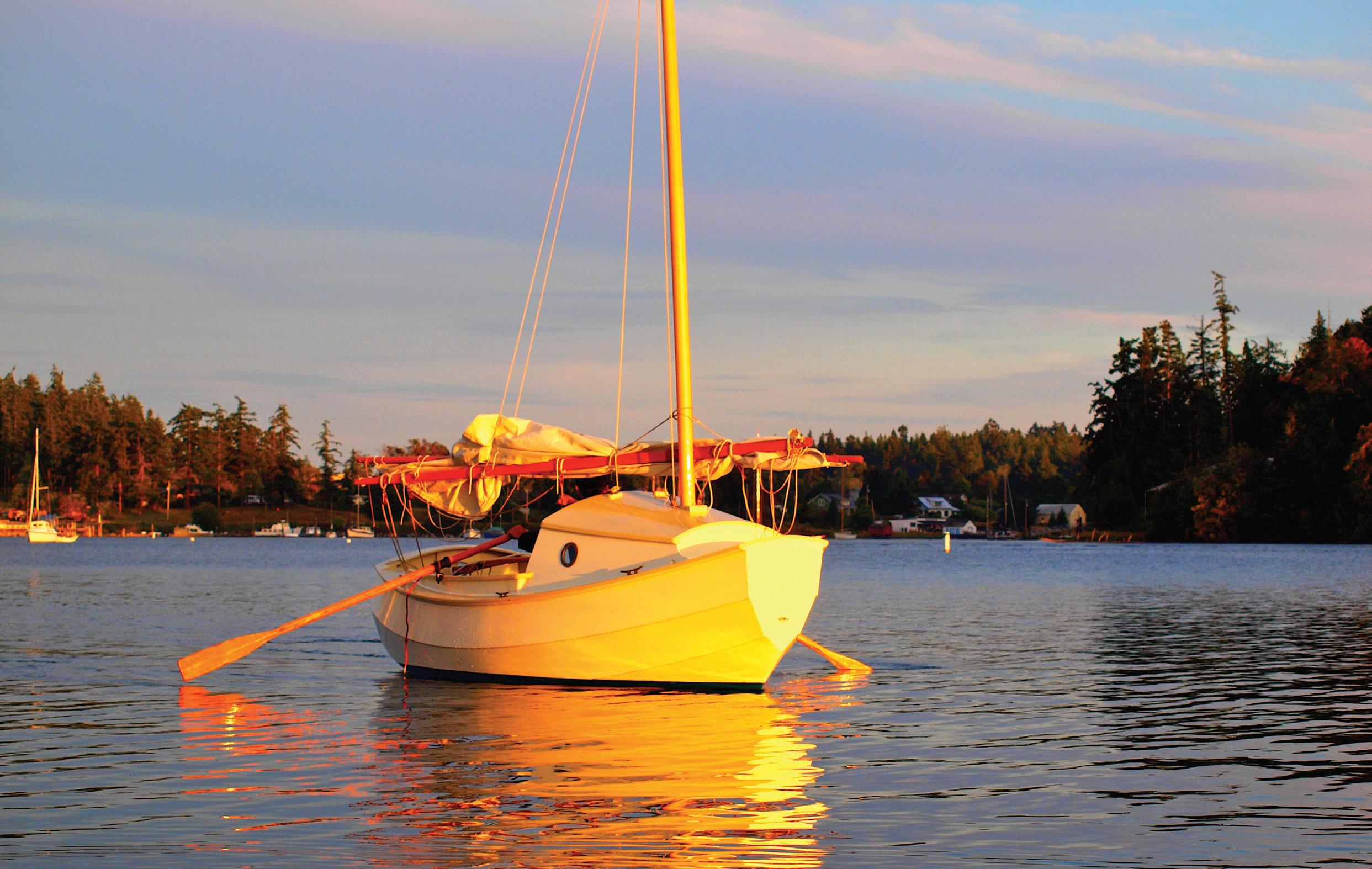
Case in point: when commenting on historic construction techniques, John mentions that, “There is much to be interested in, and I encourage people to be interested in the traditional craft, but
it’s only of limited value if not building a traditional boat.”
This leads to an associated aspect of his work: the ability to successfully reimagine these crafts using contemporary materials and design principles.
Gone are the chunky wooden dinghies you may remember from childhood –instead, he has embraced the wonders of plywood and epoxy.
“The possibilities for designing within this medium, which is where most of my work is done, are much wider than say, traditional carvel or clinker designs. We can today achieve shapes and weights that were, if not impossible with traditional construction methods, extremely difficult to build.”
One of the more recent examples of this is the Sei, a five-metre double-ended craft inspired by a set of plans John found in a museum in Hardangerfjord, Norway.
While the Sei has a distinct Viking aesthetic, the design adaptions and use of modern materials have made it more
stable than its Norwegian counterpart and – crucially – 50% lighter. (This is also useful if you’re struggling to source traditional Viking construction materials such as animal hair, moss and tallow.)
Of course, the members of John’s Facebook page know all this already, not only via articles, but through their own constructions and sailing adventures. If a boat building project of your own sounds appealing, why not join them at www. facebook.com/groups/JWDesigns.
You can find John there, too, now he’s finished his move to dry land after a decade on the water.
“I do have a need for a really nice rowing boat, about 15 foot would be nice and I’ve started the preliminary sketches for that,” he says. “Rowing on a mirror calm lake, late on a warm moonlit summer’s night, is something that I’m very much looking forward to.” n
NGAHURU • AUTUMN 2023 19 Heritage Quarterly
AUCKLAND
A Welsford-designed SCAMP rows to anchor.
First fruits – propagating a living link to our oldest properties
WORDS: John O'Hare IMAGES: Heritage New Zealand Pouhere Taonga
As the Greek proverb goes, “a society grows great when old men plant trees in whose shade they will never sit.” When Heritage New Zealand Pouhere Taonga Hokianga Property Lead Alex Bell took 30 heritage peach trees to the recent Bay of Islands A&P Show he wasn’t sure how things would go.
“There is a period in the 1840s where the missionaries think the site at Te Waimate is too barren and so they start a small native tree nursery to help repopulate the property.”
Although the site at Te Waimate is anything but barren today, Alex has revived that fine tradition of having a small nursery onsite to provide botanic continuity.
The 30 saplings are the first fruits of a Covid-19 project that saw Alex – a keen gardener but not a trained horticulturist – source a variety of seeds and cuttings from different Heritage New Zealand Pouhere Taonga places in Northland.
“I didn’t know how it was going to go and it ended up being a neat way to get people engaged in a different historical aspects of our heritage places, and thinking about some of our lesser known sites,” he says.
As it happened, visitors to the show purchased all 30 of the plants propagated from the historic orchard at Kerikeri’s Edmonds Ruins within a few hours of the gates opening.
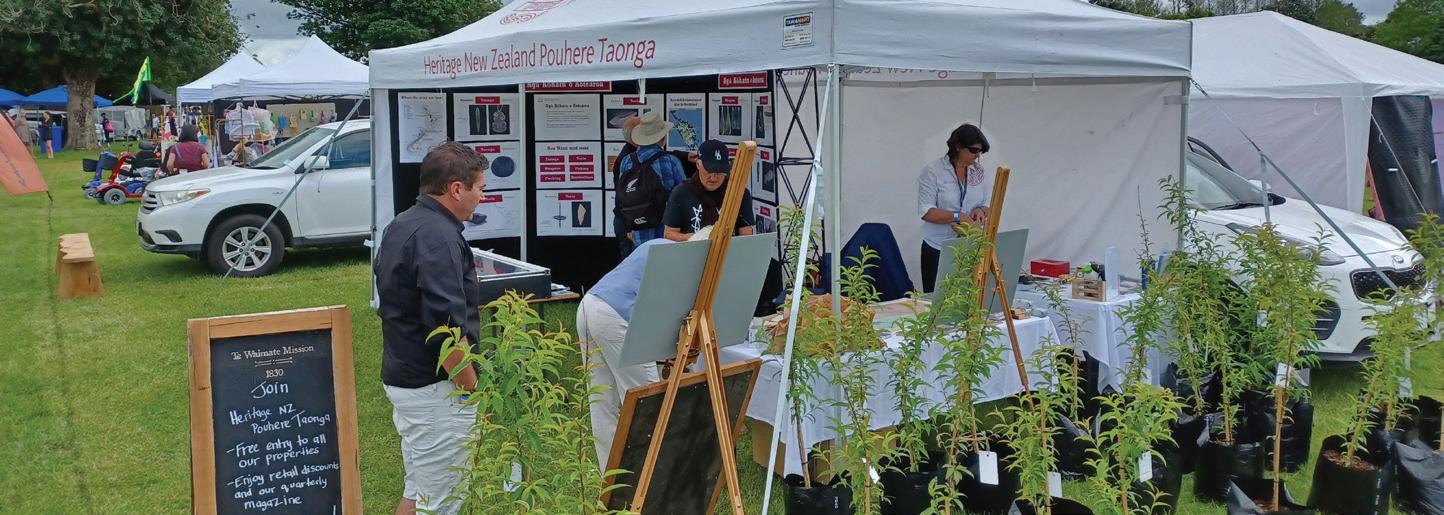
“Over the last two years we have been building up a nursery at Te Waimate Mission to let us propagate cuttings and seeds for our own sites to keep the gardens stocked with plants. There is also a bit of room for propagating interesting things we find along the way,” he says.
“At the moment it’s a mix of fruit trees –plums, peaches, pomegranates, lemons
and figs with some ornamental species like wisteria and gladioli.”
Alex believes that the undertaking is a great way to retain connections to the landscapes the heritage buildings sit within. “Some of these plants have specific histories attached to them – the people who planted them or the times and places they are associated with. In the case of a place like Edmonds Ruins, these plants are propagated from the remnants of the original orchards,” he says.
“It’s an extension of what we do with the buildings – except we’re conserving the wider place. The gardens and grounds are part of visiting these buildings.”
Heritage gardens can be a little strange according to Alex.
“In some ways they’re an odd part of our site. The houses are frozen in time but the gardens keep on growing. The big trees that grace Te Waimate today, for example, are different from those that that would have been on site in the 1830s,” he says.
“Collecting cuttings is a dangerous habit because you end up with a thousand plants to care for. While there are commercial operators doing this on larger scales, I’m more interested in focusing on our heritage places and the plants we need now and in the future,” he says.
“Planning is important. To be successful you need to collect cuttings and seeds at the right time and to leave enough time for development before they are ready to be planted. The peach trees were two years in the making between seed collection, propagation and then sale.”
Our heritage places have the advantage of incorporating nature with historic buildings and other areas.
“There are plenty of places around the world that need to recreate those natural spaces and that chance for education. I find international visitors in particular really love what we so often take for granted.”
“We have to curate and maintain what we currently have, but also plan for the future – trees die, storms come along. I am now that old man potting up trees for future generations’ shade,” he says. n
NGAHURU • AUTUMN 2023 20 Heritage Quarterly
KERIKERI
Alex Bell at Waimate show stall.









































